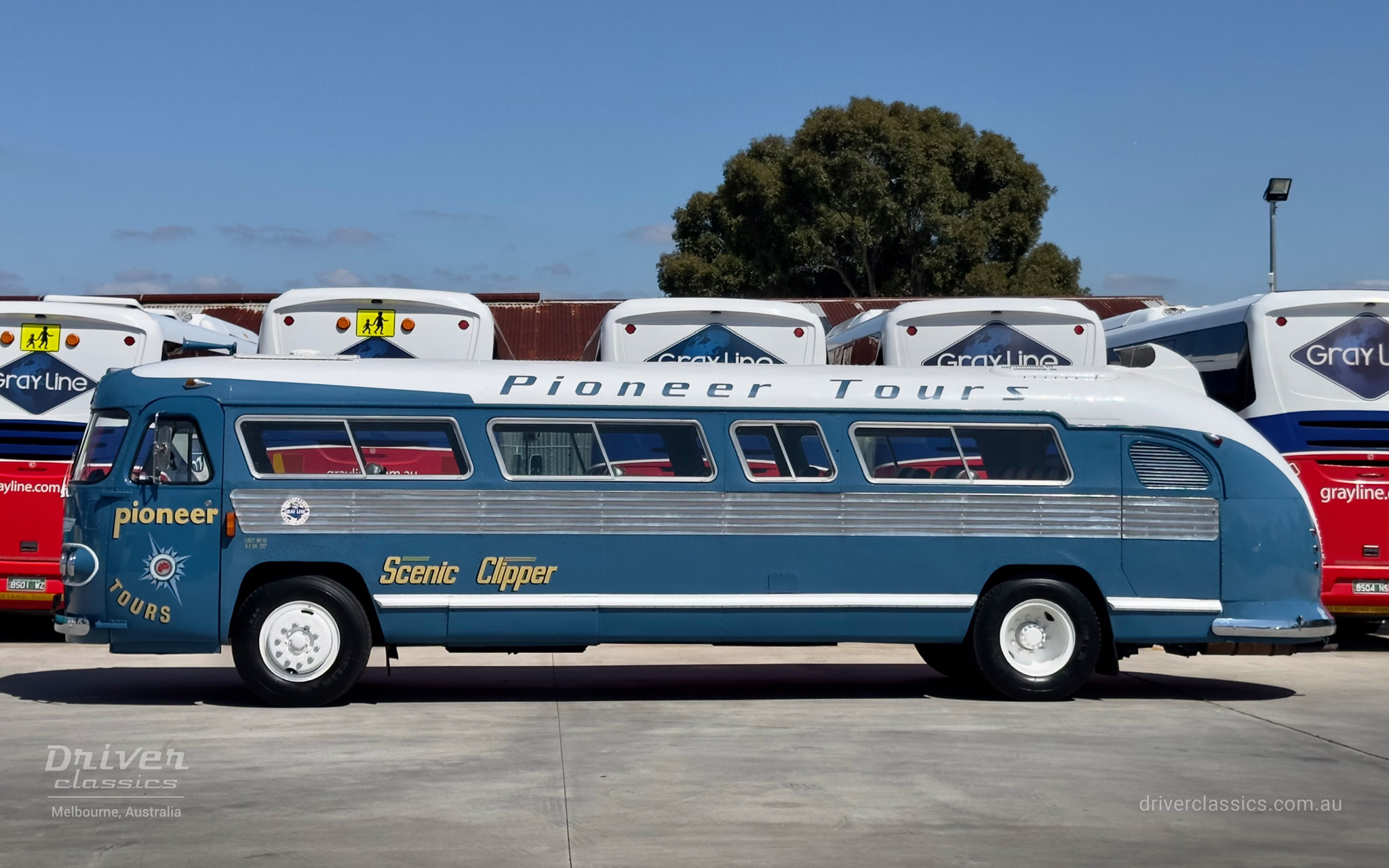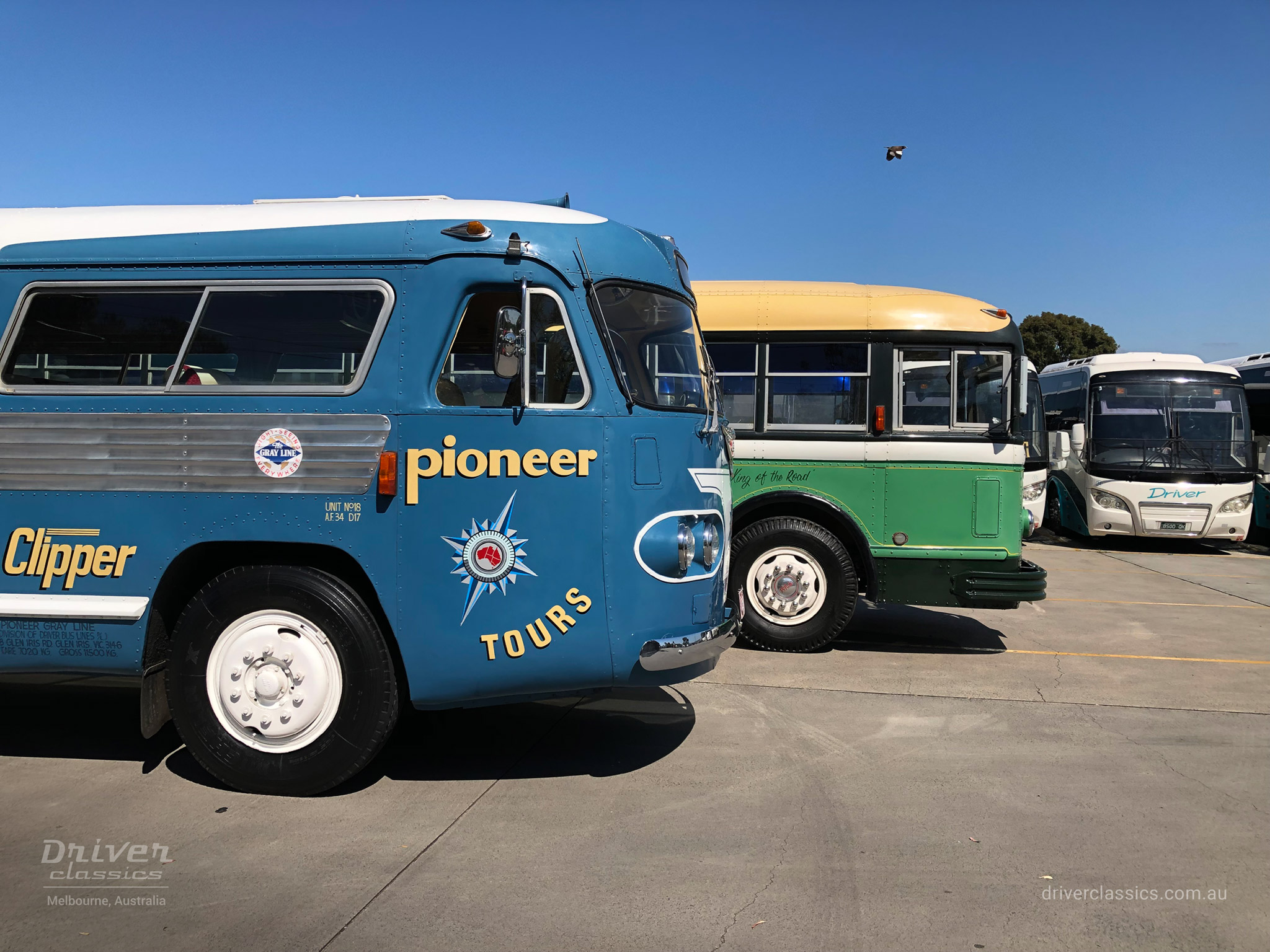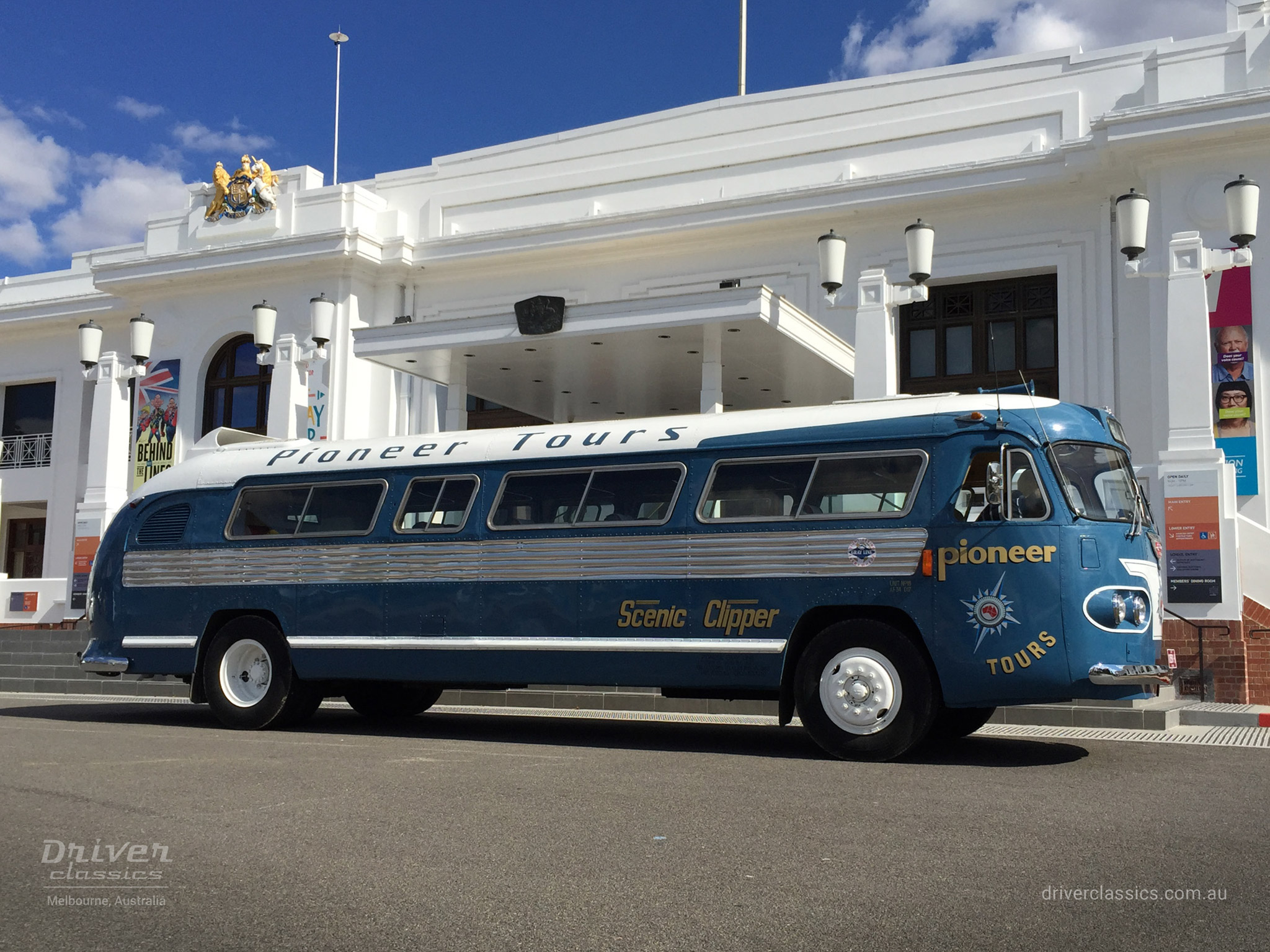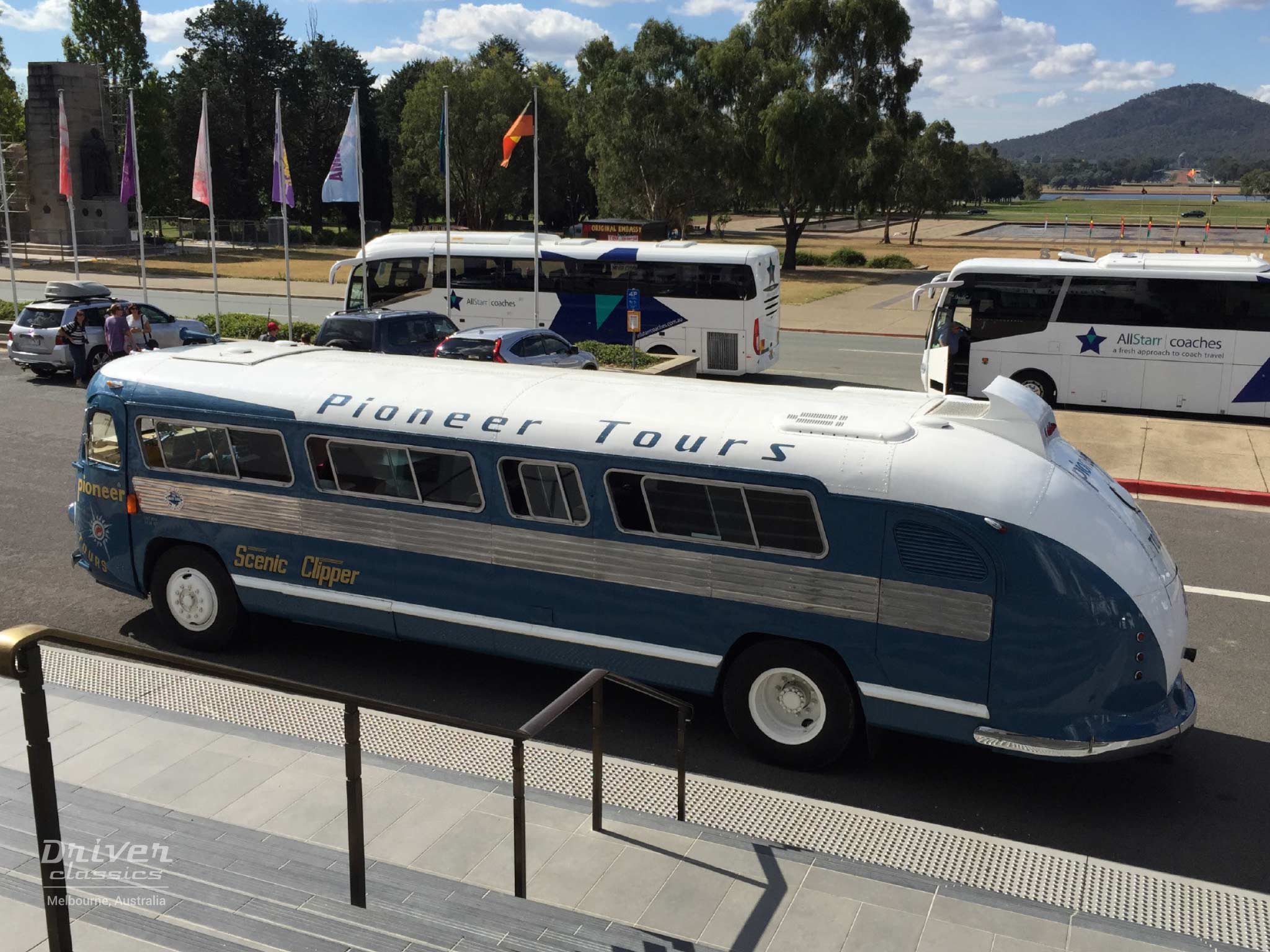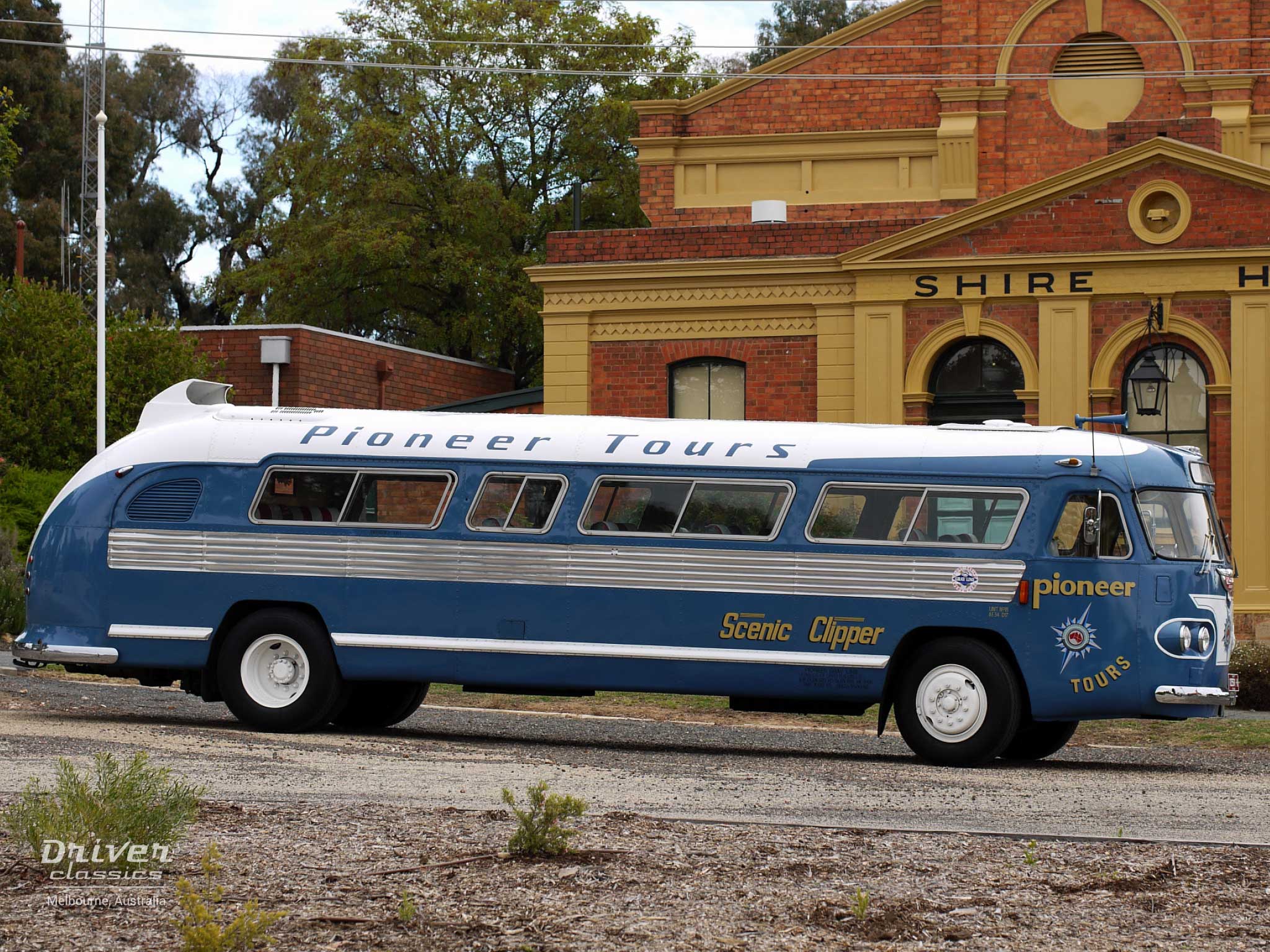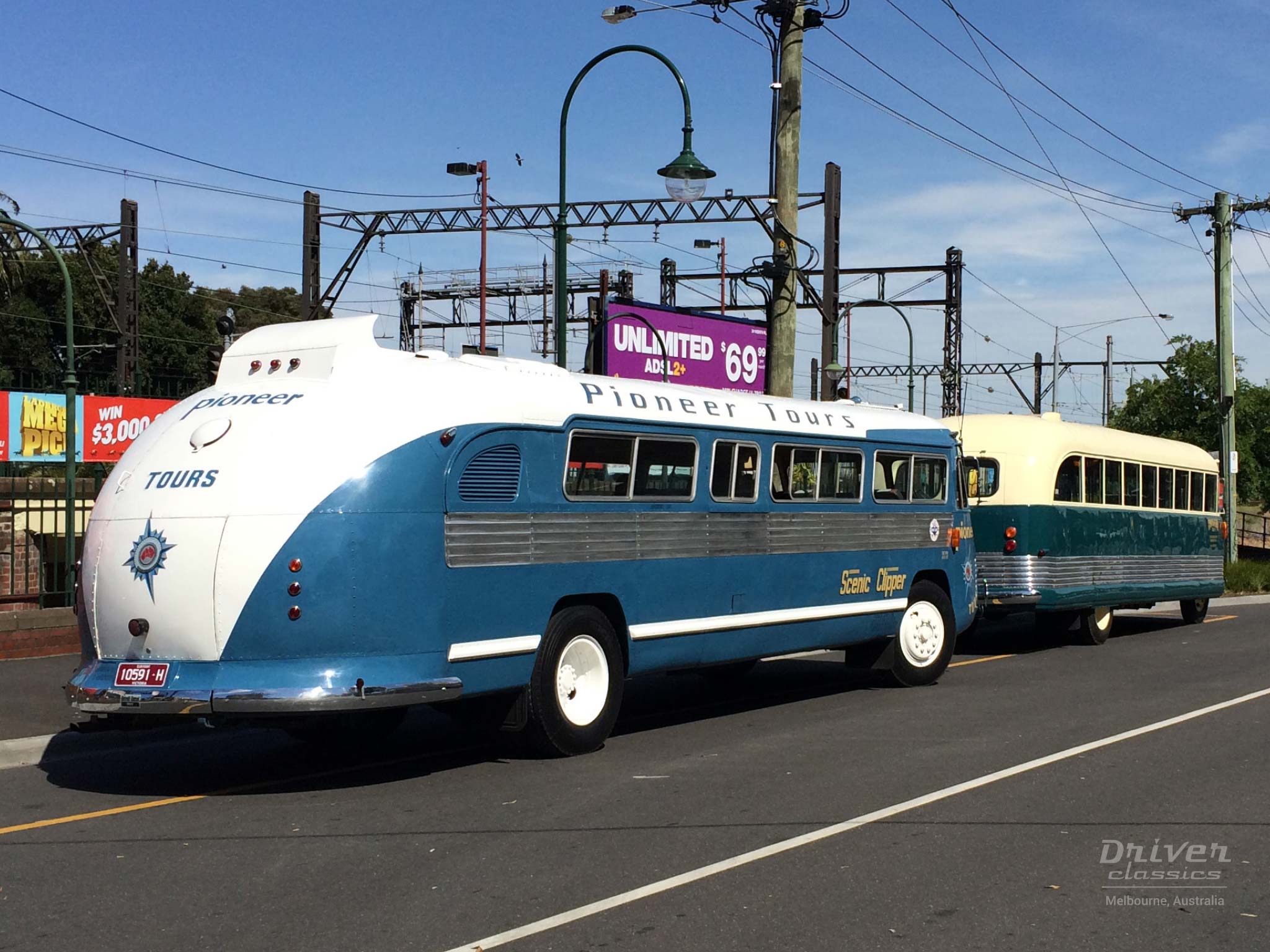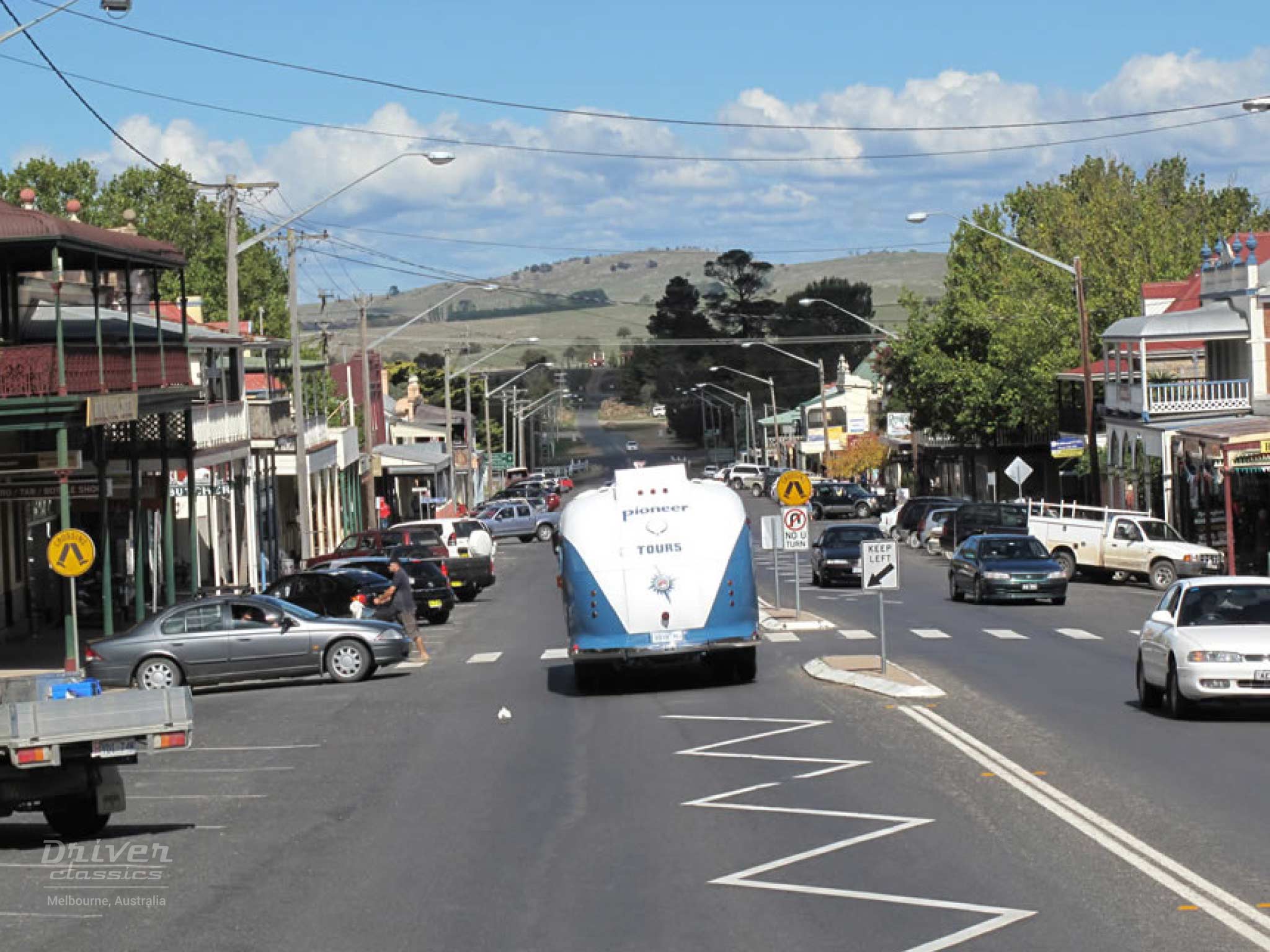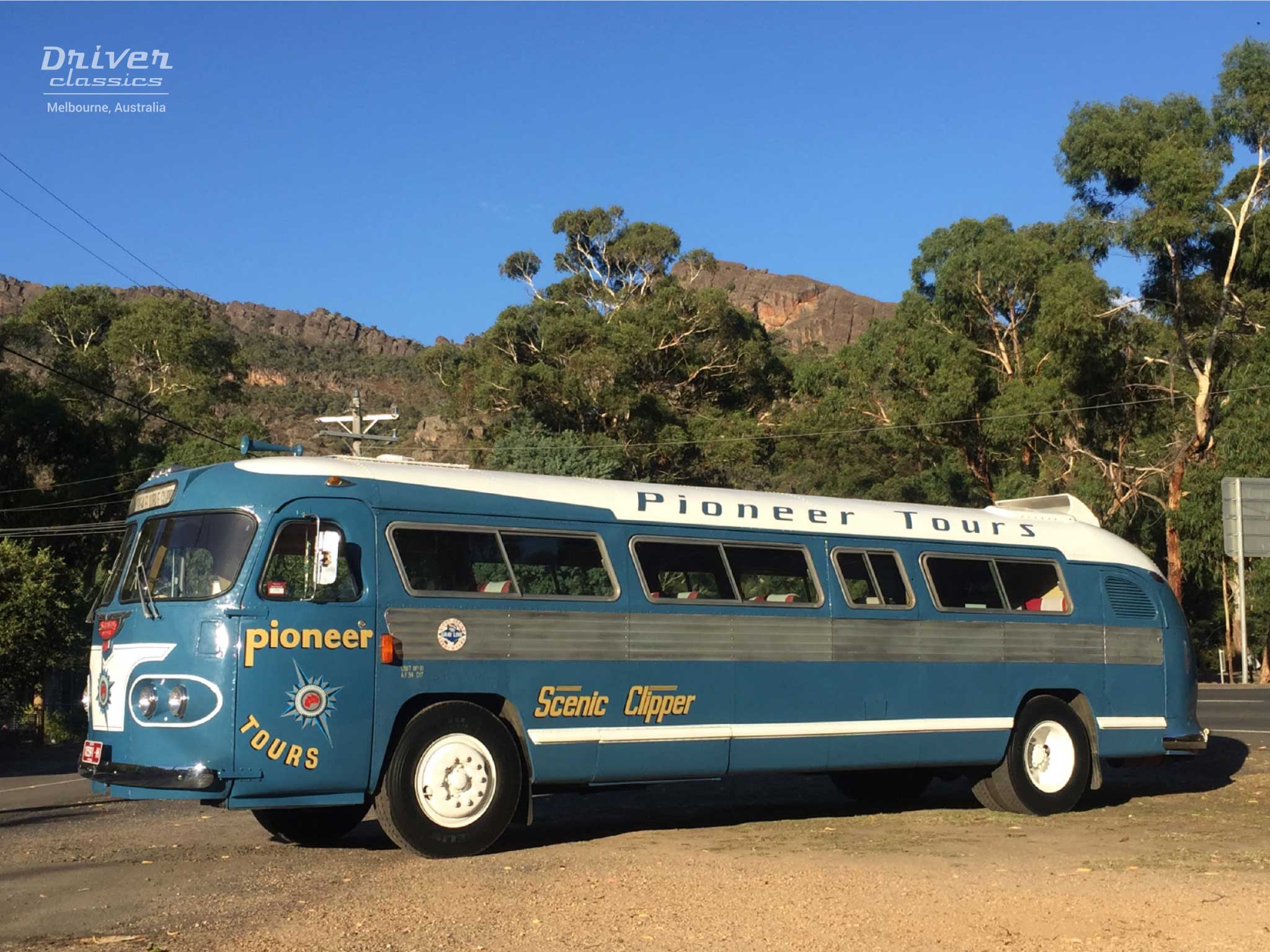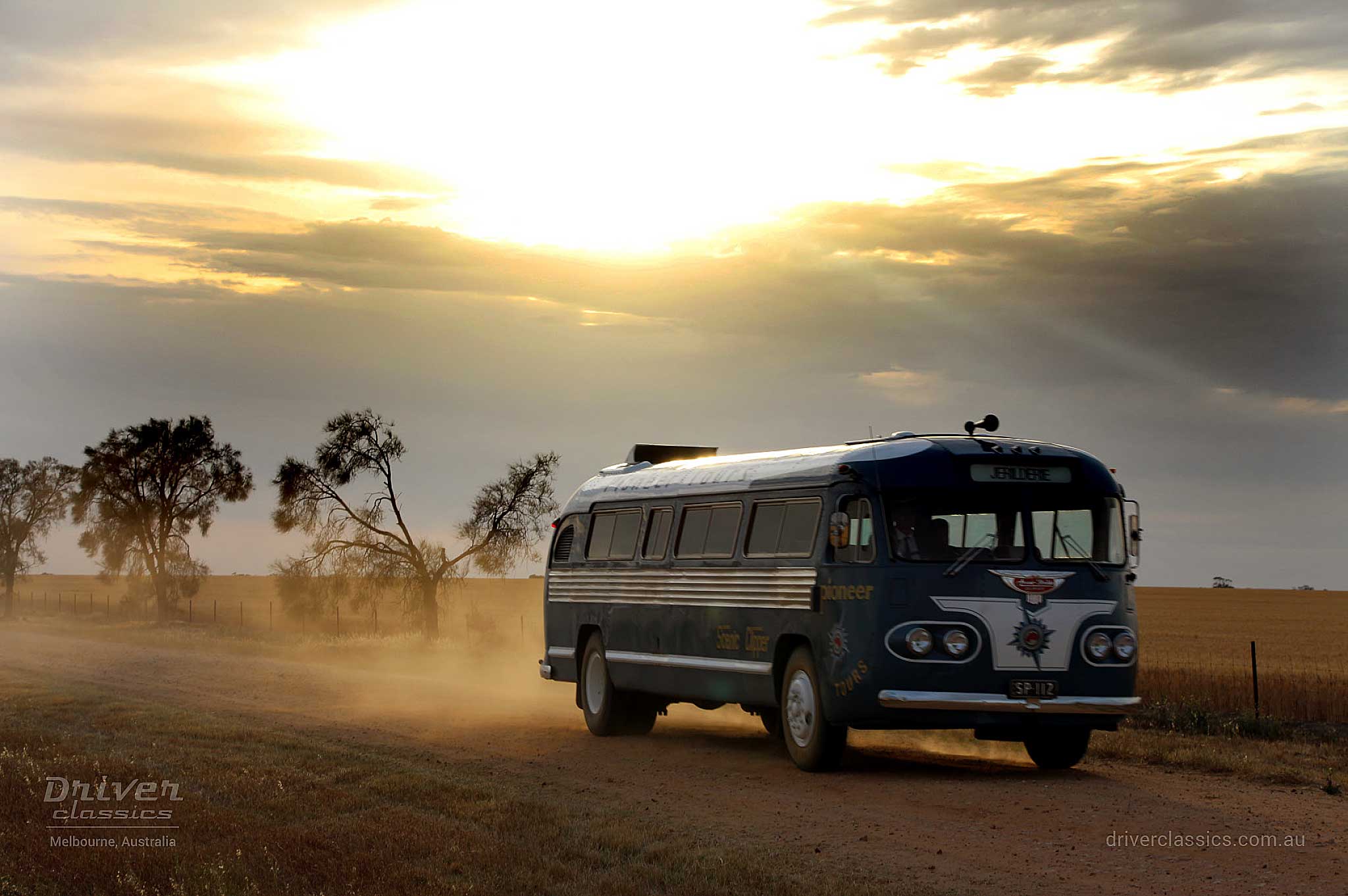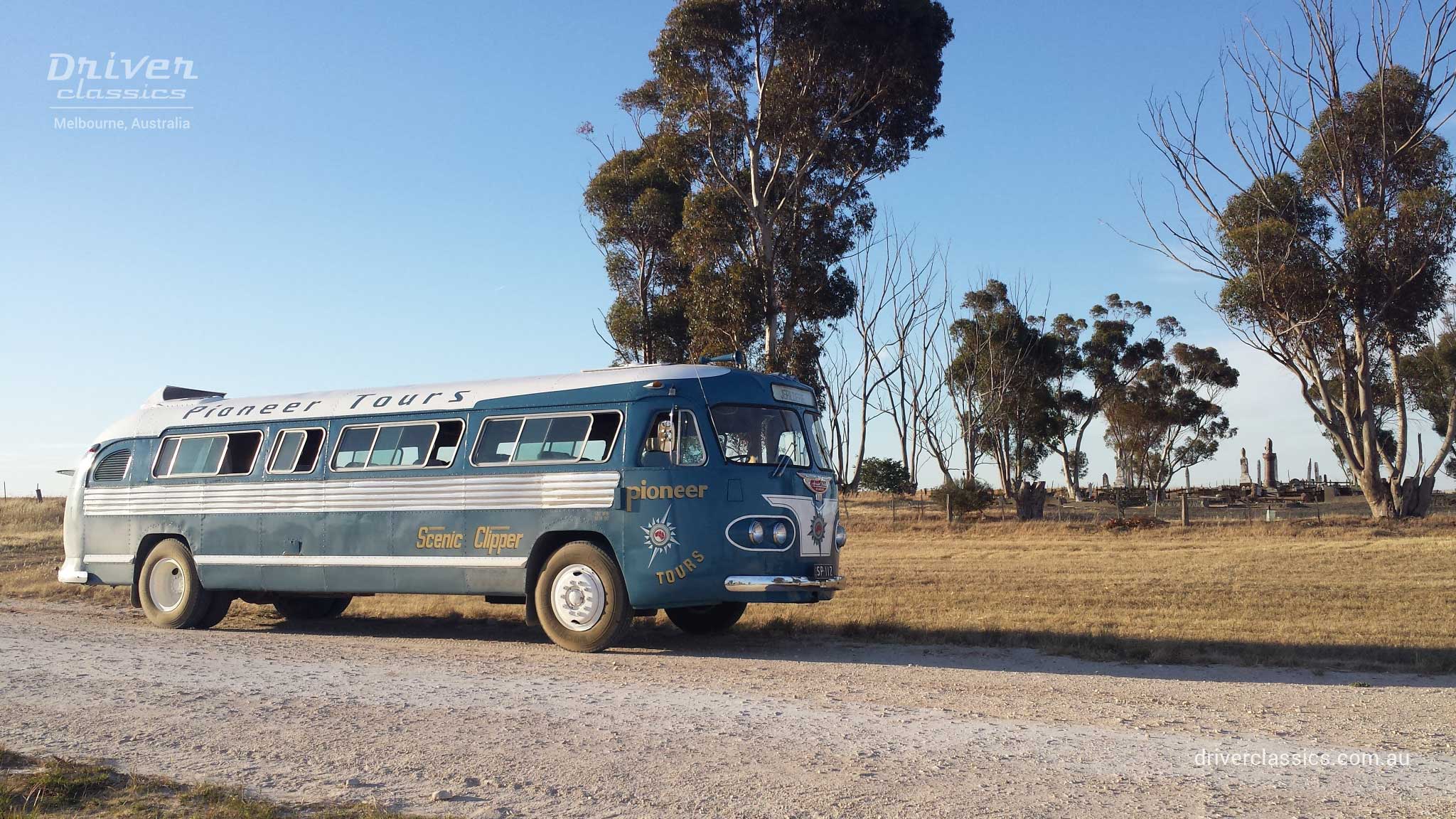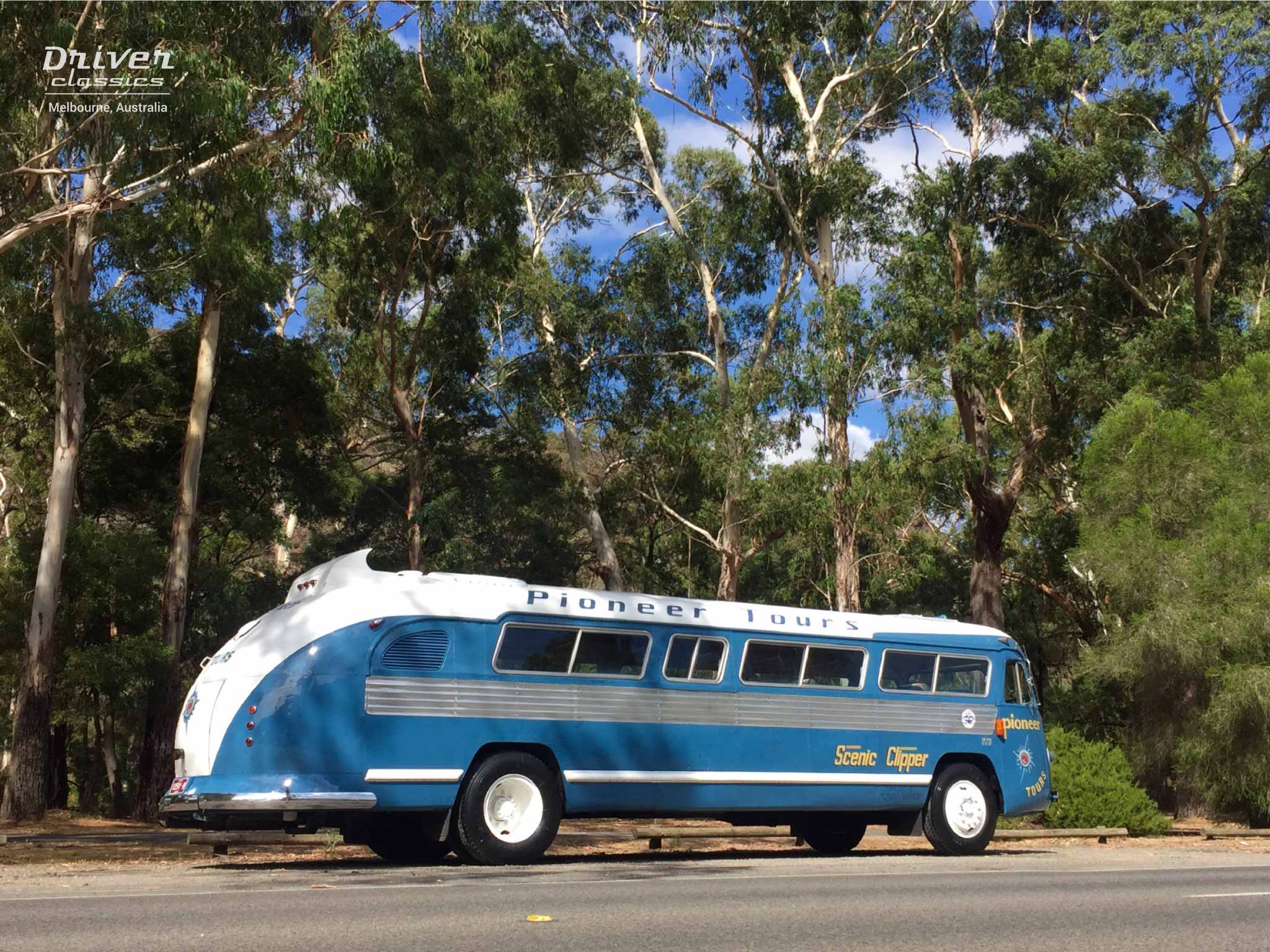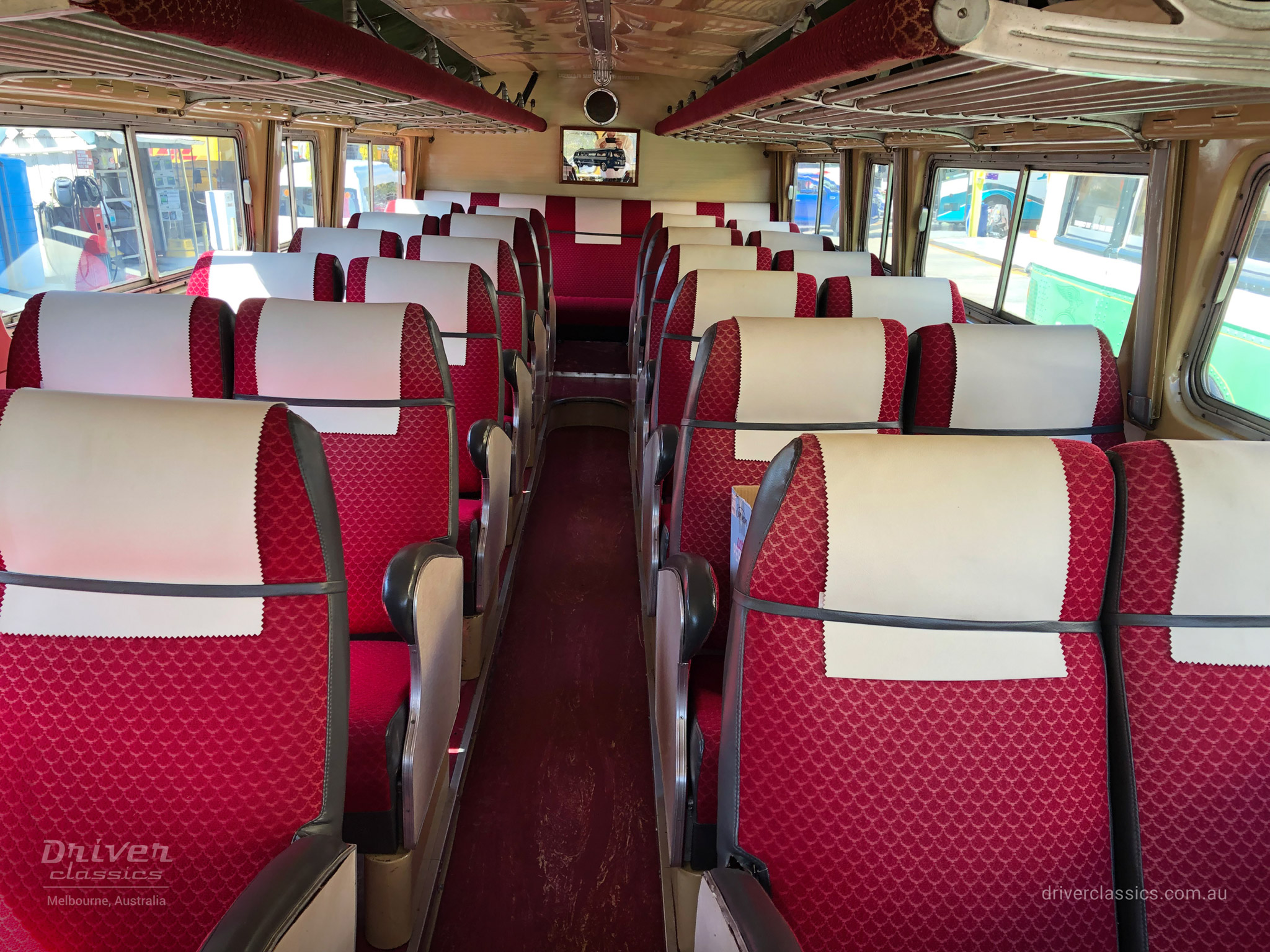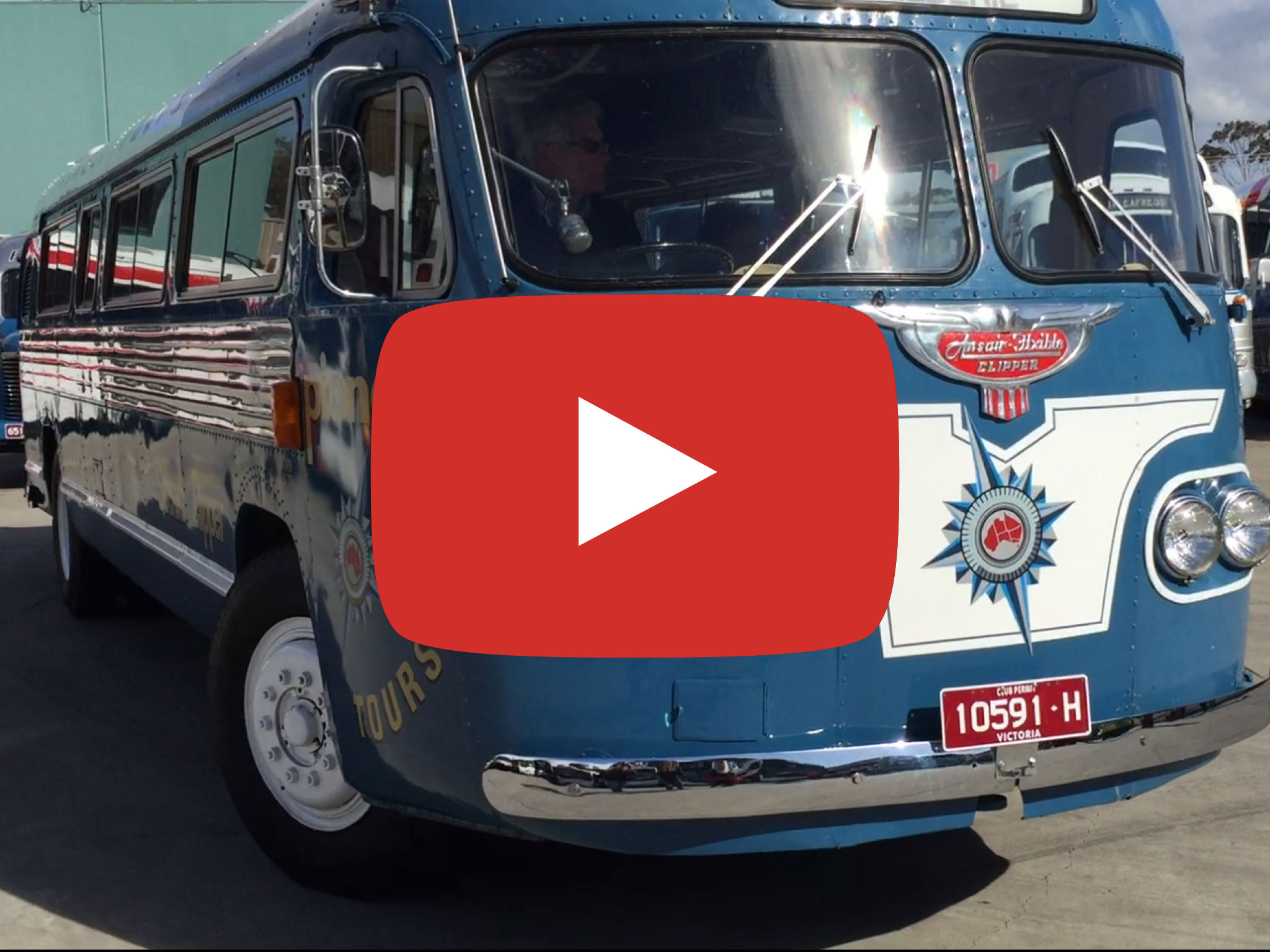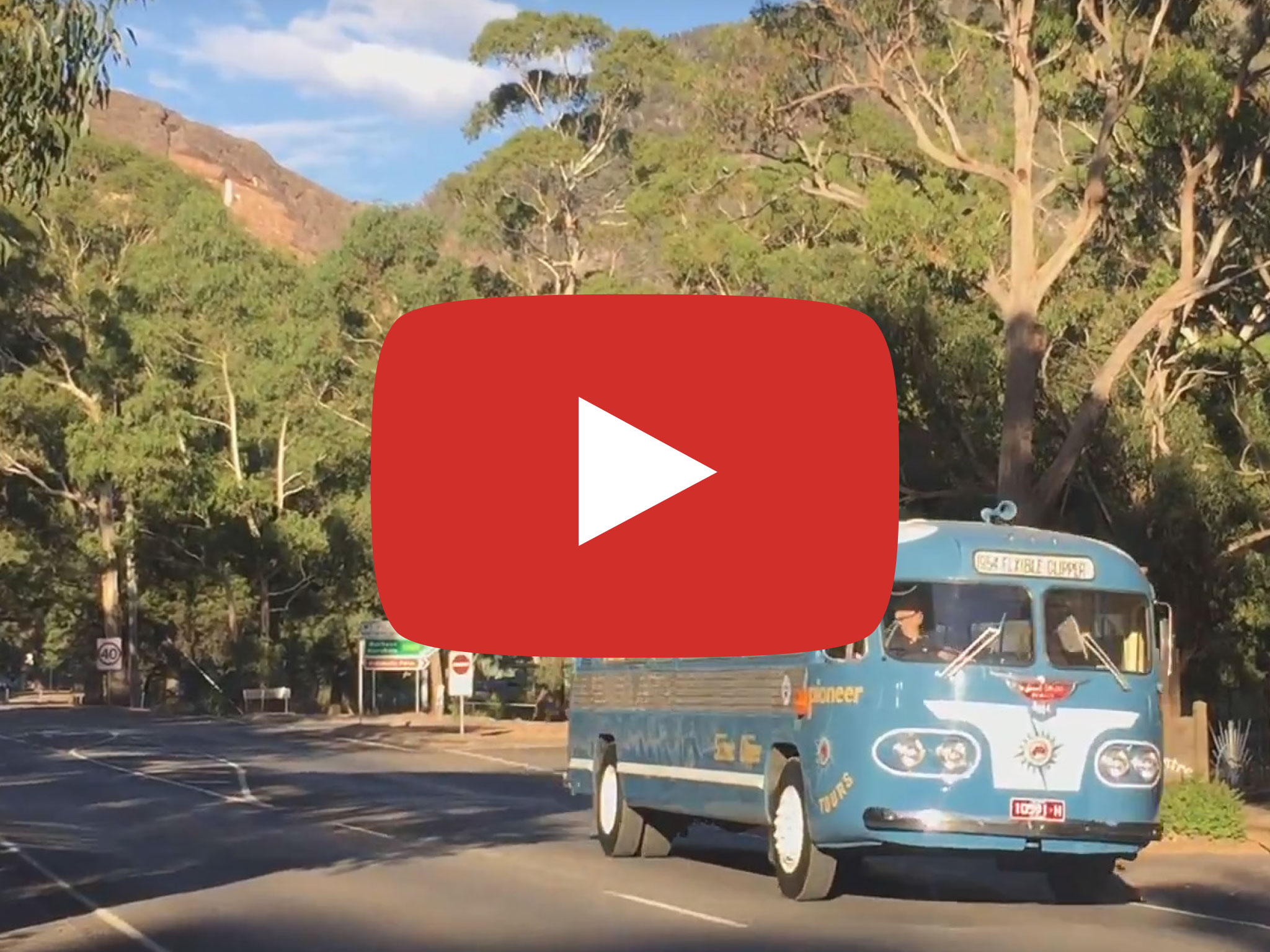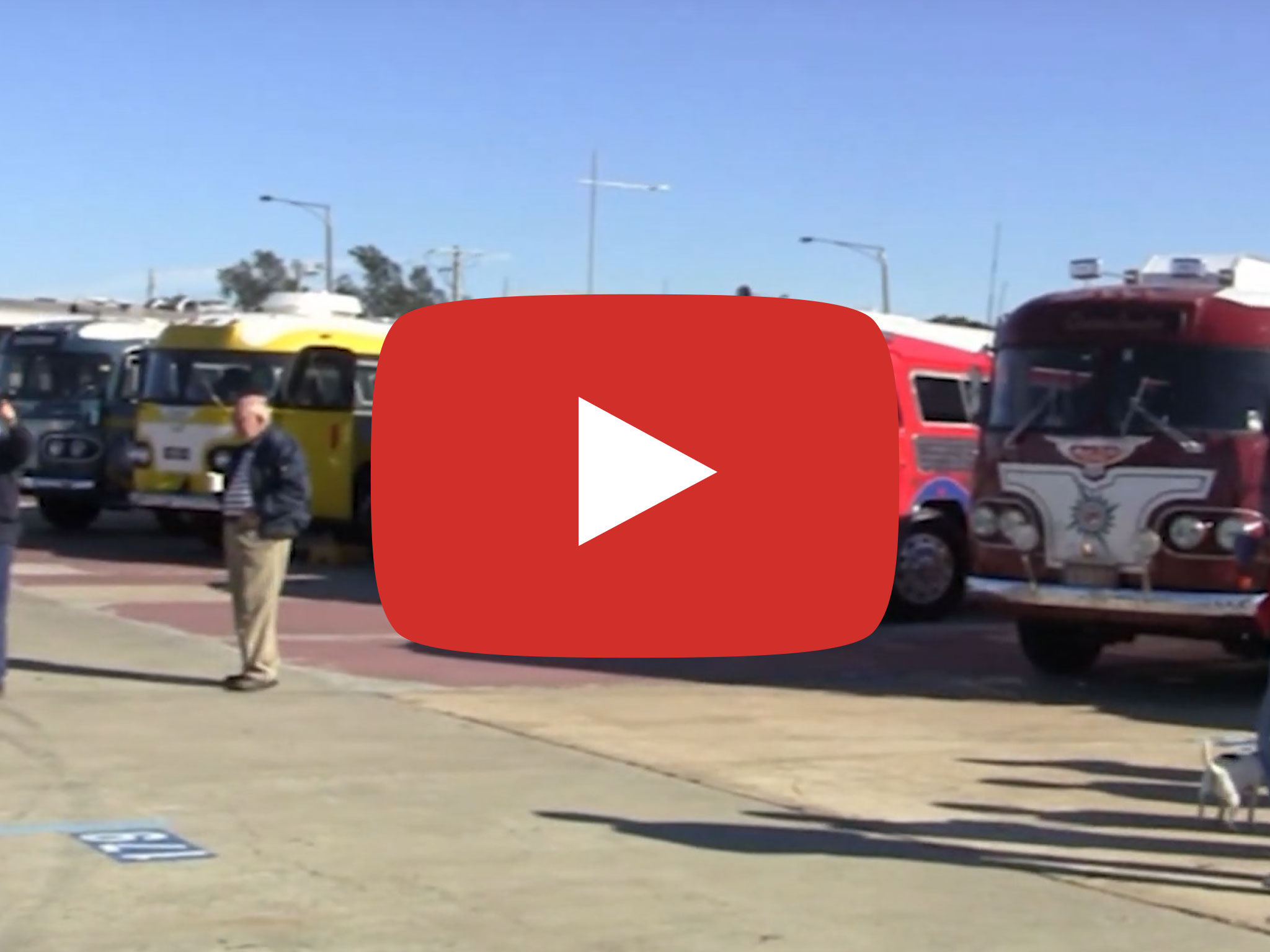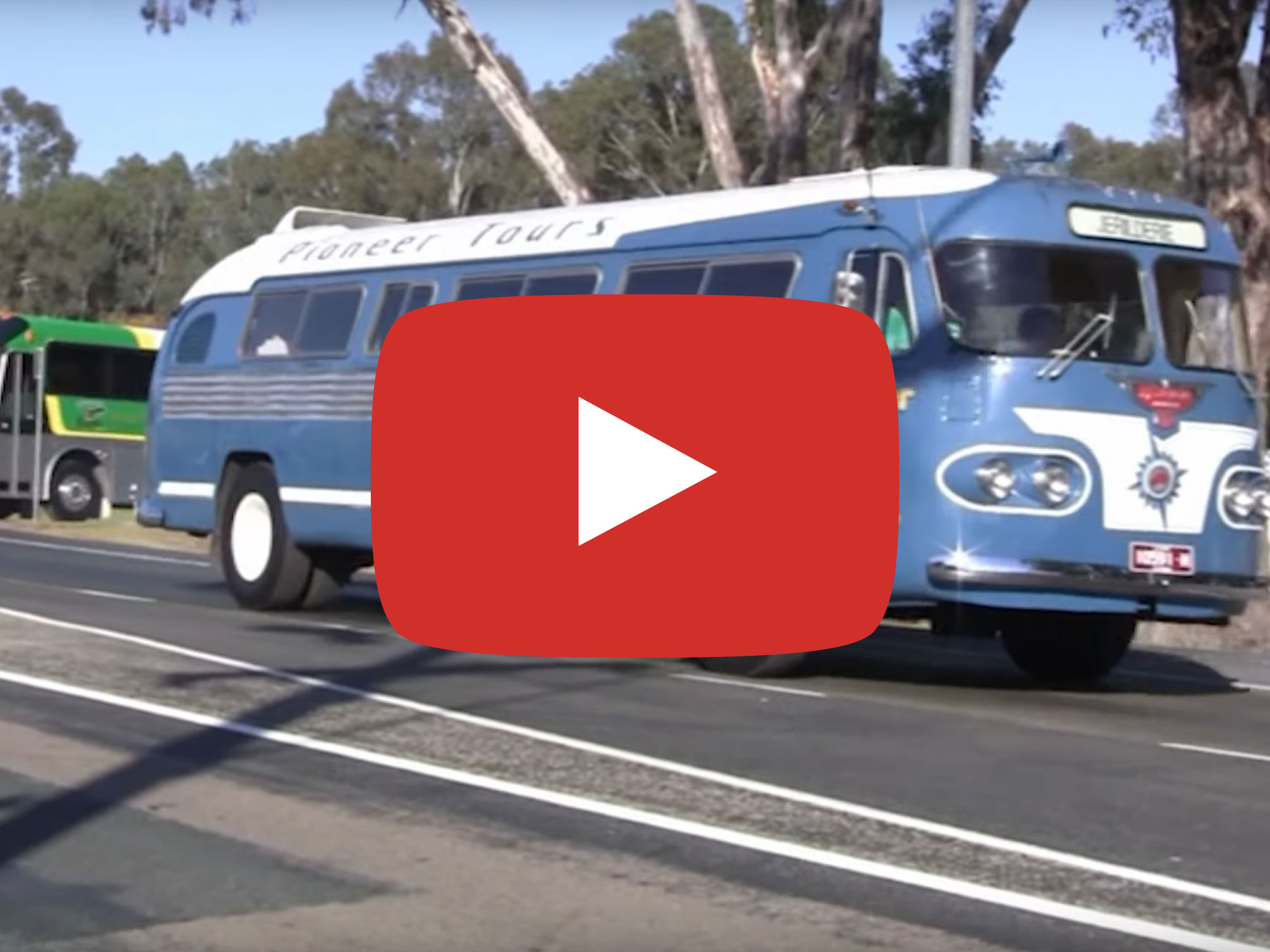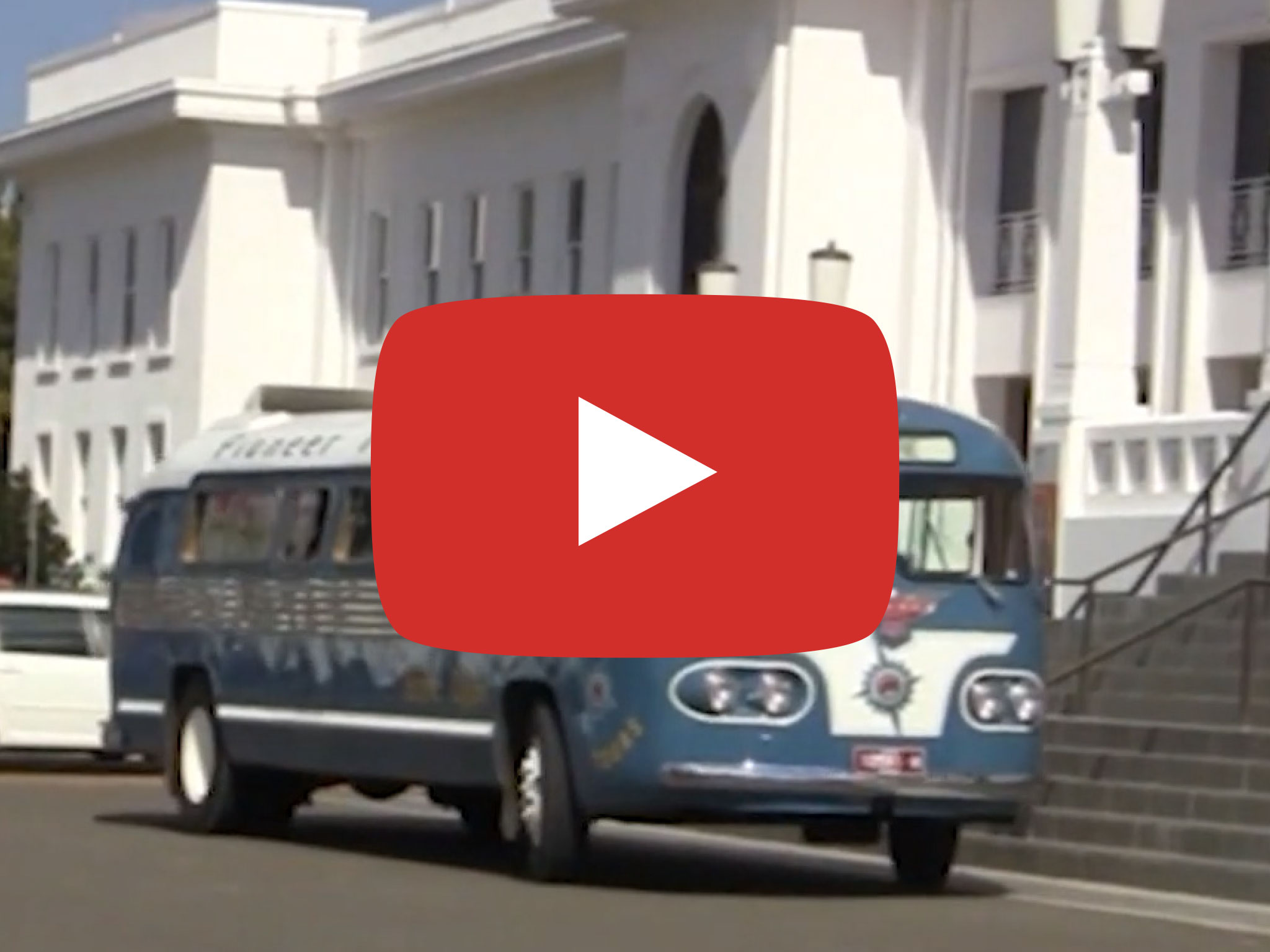1954 Ansair Flxible Clipper (Build #AF34, Fleet #D17)
The streamlined Flxible Clipper set a new standard for coaches in Australia
(Click on photos to enlarge) - Images free to share and distribute but please acknowledge driverclassics.com.au
About This Ansair Flxible Clipper
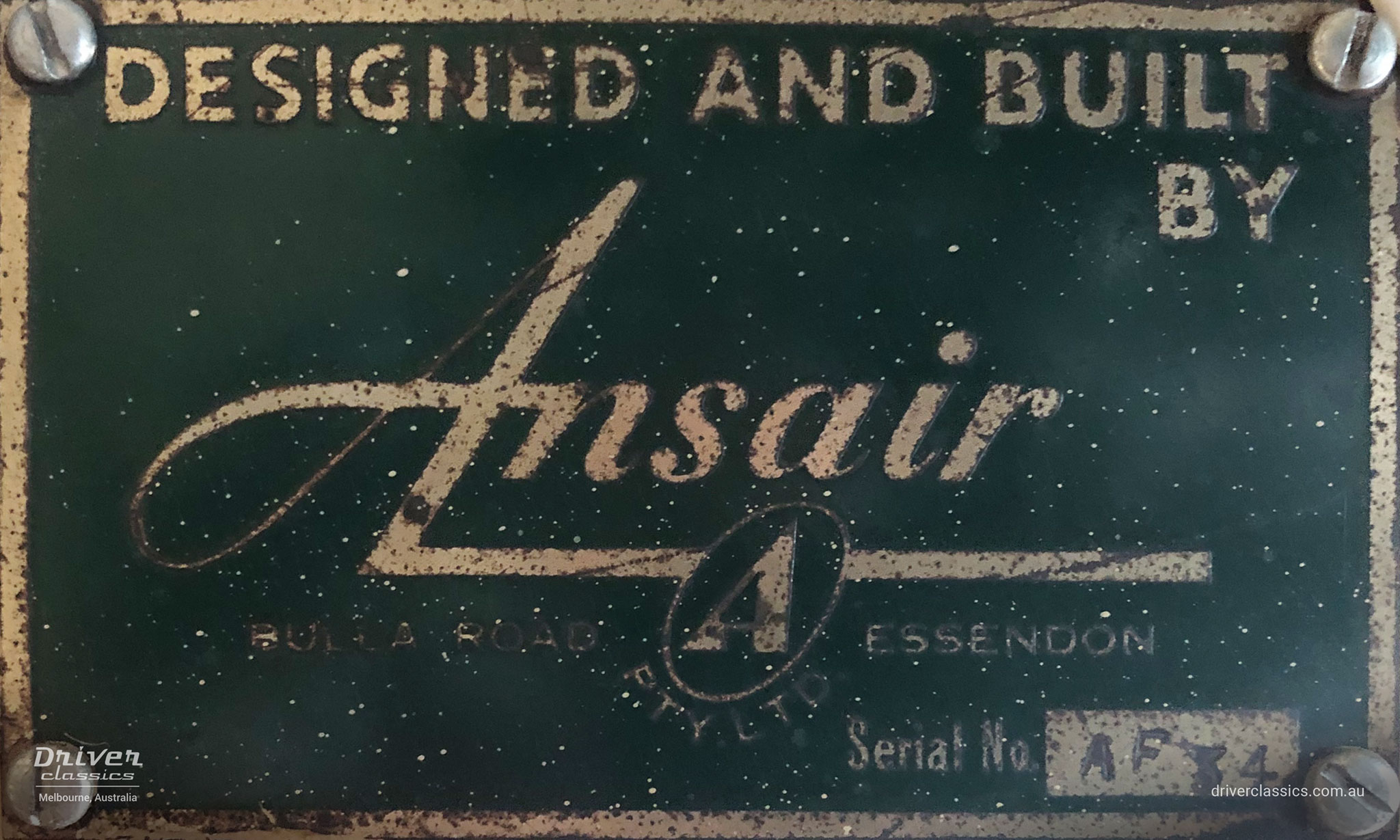
Driver Classics' 1954 Ansair Flxible Clipper, AF34 was new to Cooks Sedans in Tasmania. In 1961, it became D17 in the Pioneer fleet when Pioneer took over the intercity routes operated by Cooks. It later became D104 for Tasmanian Coach Lines, then a workers’ lunch room at an orchard and was finally ‘discovered’ by Bill Hardinge for potential restoration. Bill was not so much a bus enthusiast but a Clipper enthusiast!

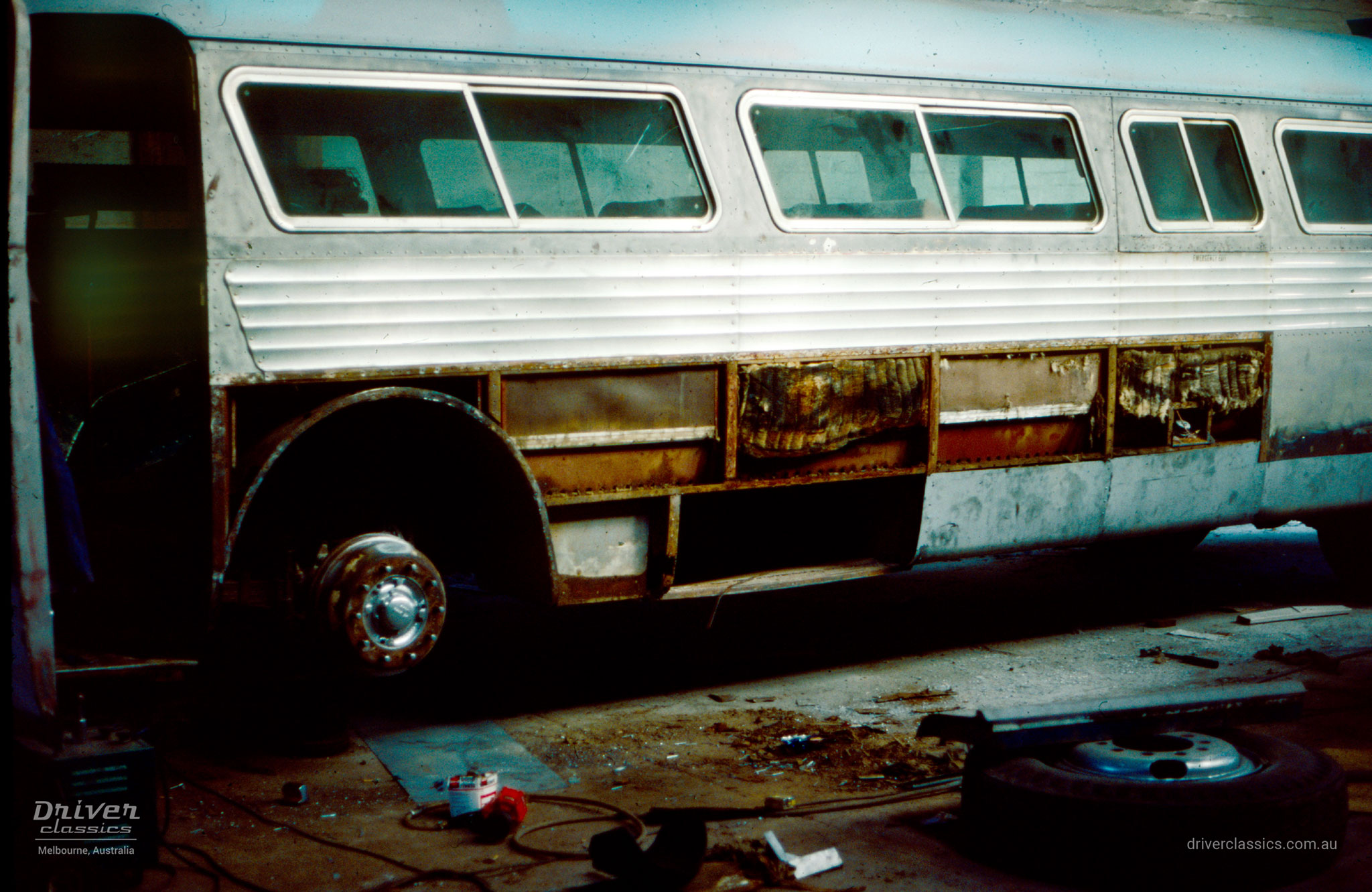
Bill shipped the Flxible to Melbourne, without its original Leyland engine and transmission, where it was acquired by Driver Bus Lines in 1983 for a full restoration. The restoration was completed by January 1985 for the 30th anniversary re-enactment of Pioneer’s first non-stop service to Sydney on January 24 1955. Ansair Flxible Clipper AF34 was originally painted in Driver colours but in 1992 it was changed into Pioneer livery.
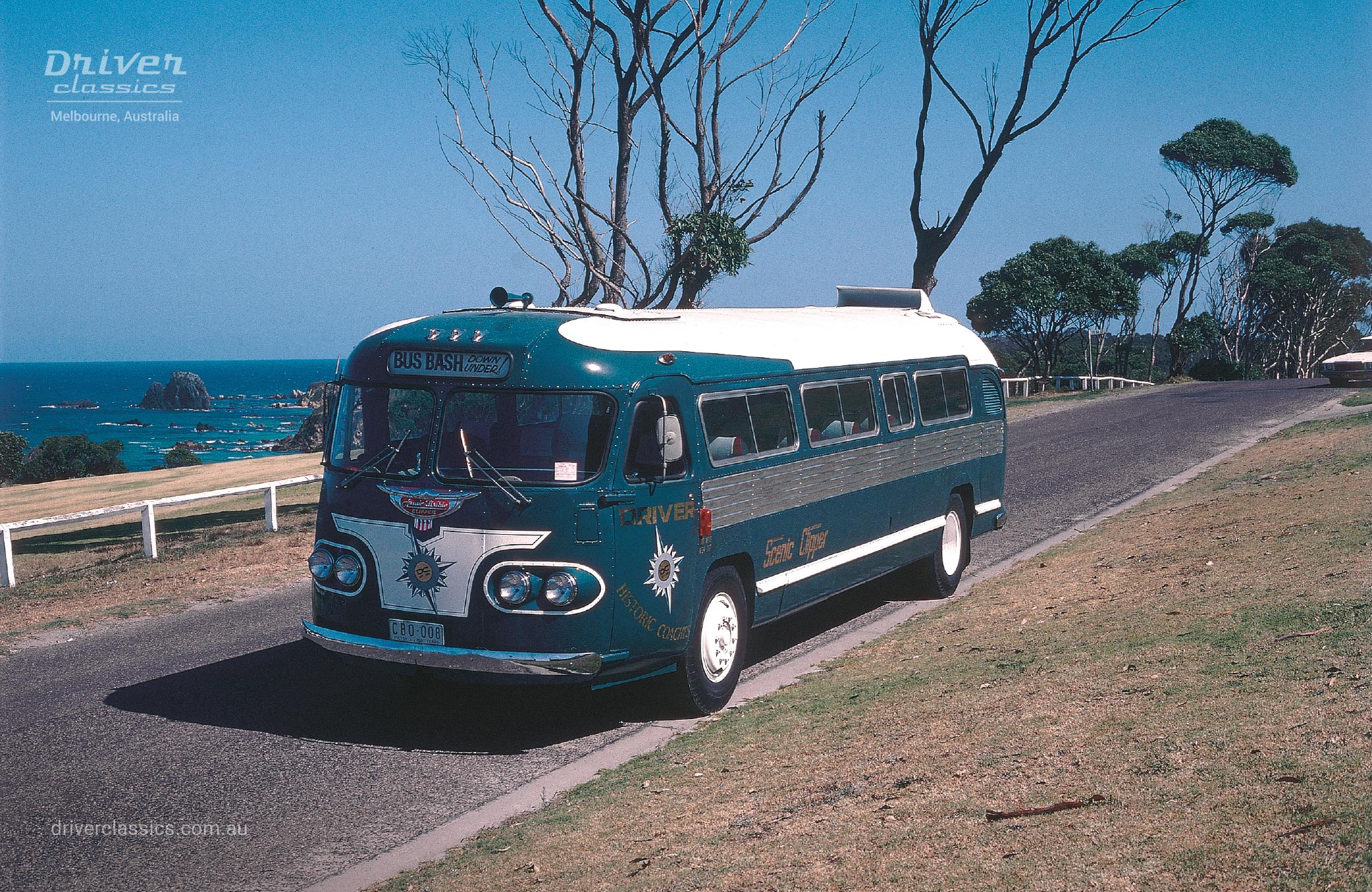

Our Ansair Flxible Clipper AF34, is powered by a GM Diesel 2 stroke engine, model 4-71, 284ci, in line 4 cylinder with a 5 speed Fuller constant mesh transmission.
The model designation AF34 stands for: AF - Ansair Flxible, 34 - build number.
The Story
Flxible was founded in 1913 as the Flexible Side Car Company by inventor and entrepreneur Hugo H Young in Loudenville, Ohio USA, based on the development of a flexible coupling to improve stability of motorcycle sidecars. The ‘e’ in flexible was later dropped so the name of the company could be trademarked. The company moved into commercial vehicle production and later found a lucrative niche with its art deco, streamlined Clipper coach first released in 1937. Flxible declared bankruptcy in 1995 and at the time was the largest transit bus manufacturer in the USA.
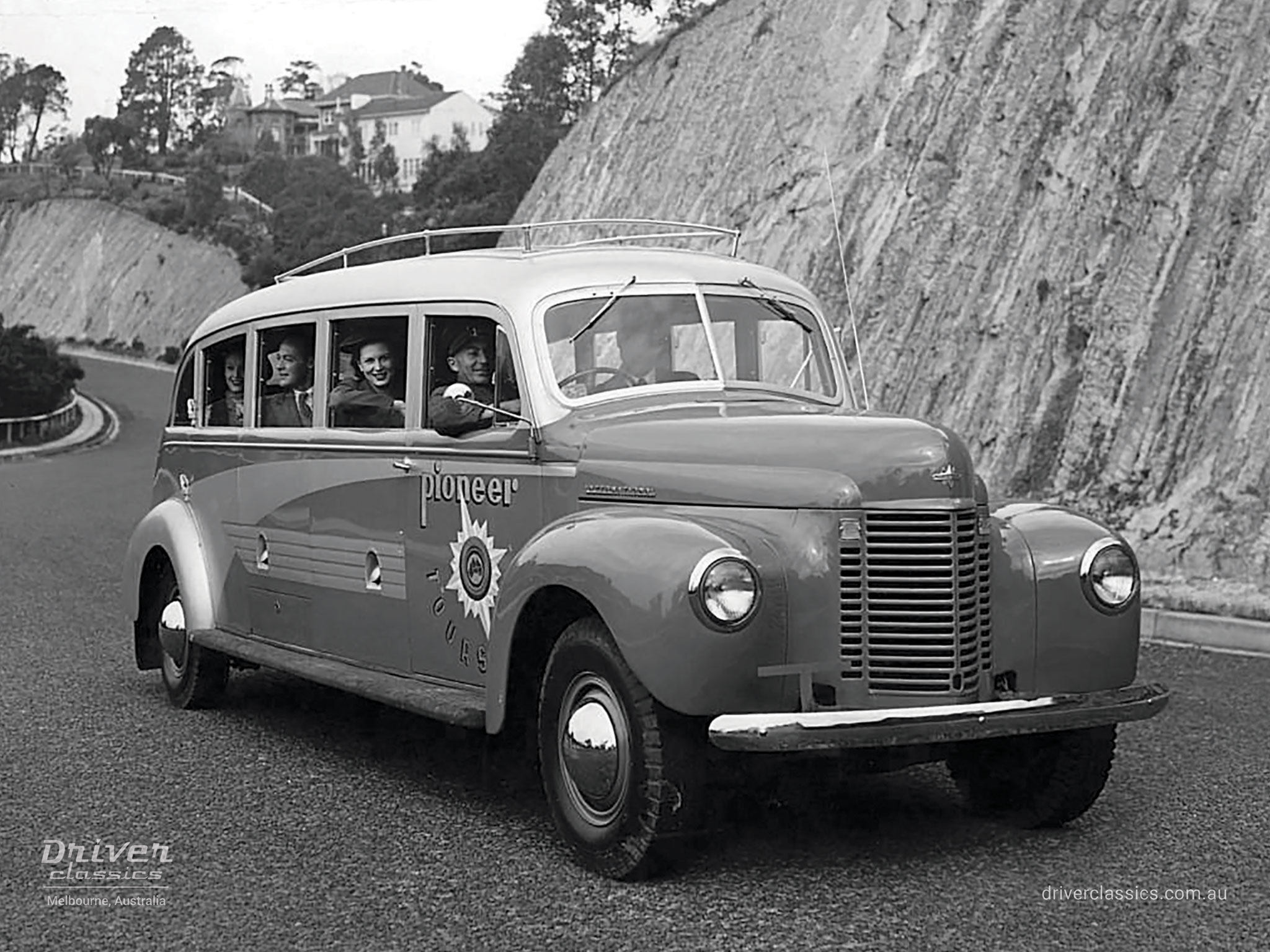
In the late 1940s, Pioneer Tours owned by Ansett Transport Industries (ATI), was operating conventional, engine out front International KB6s, Fords and Federals with Ansair ‘Road Cruiser’ bodies. Ansair was the bus body building division of Ansett Transport Industries. Pioneer Tours was looking for a more sophisticated and capable coach to operate its long distance routes. ATI owner, Reg Ansett, favoured a US General Motors coach, the GM PD 3751 ‘Silversides’, which Greyhound in the USA was using at the time, but because of its 35 foot length it was not able to be brought into Australia. Legal maximum lengths varied in each Australian state, but in Ansett’s home state of Victoria it was just 27 feet 6 inches.
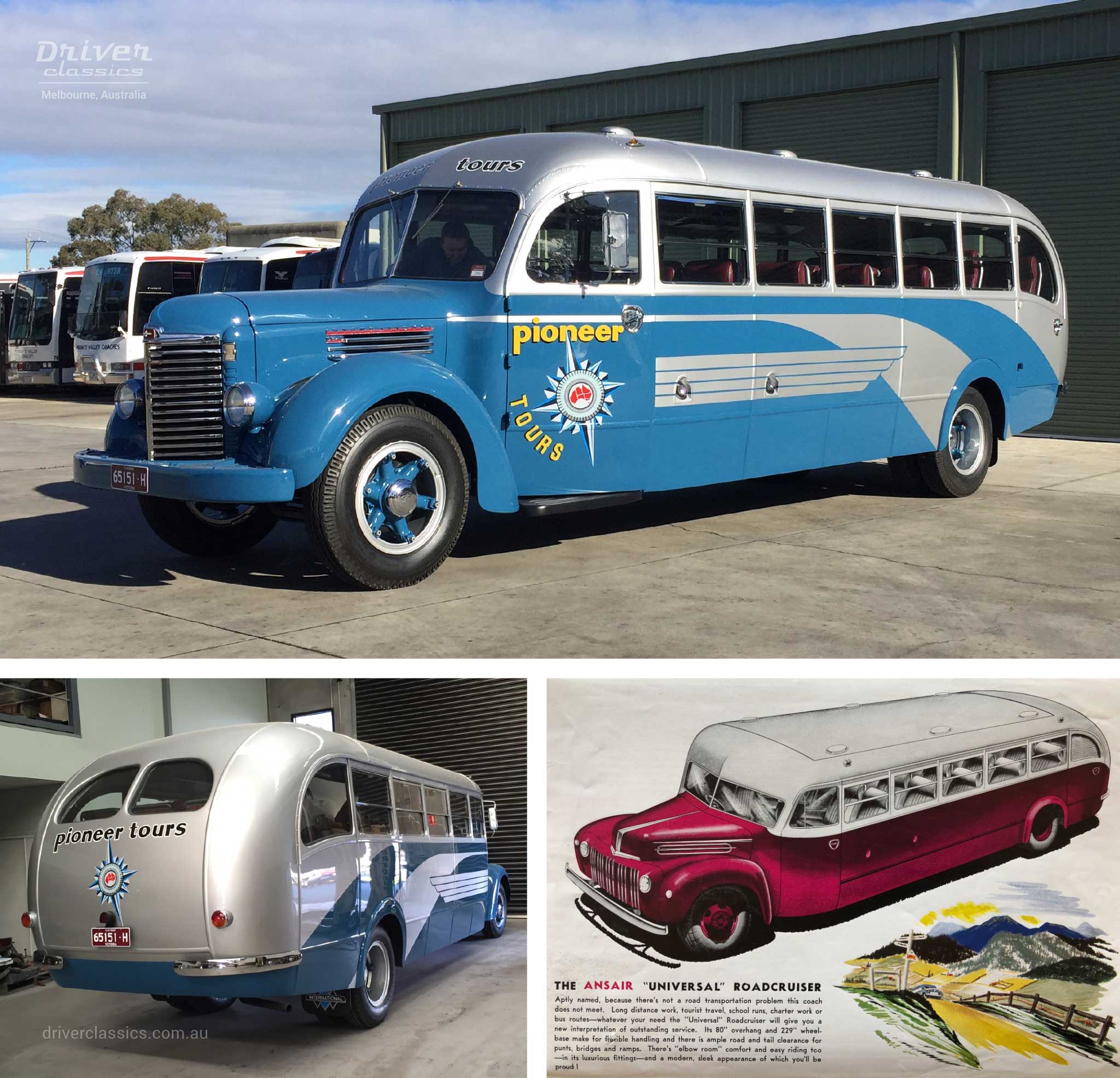
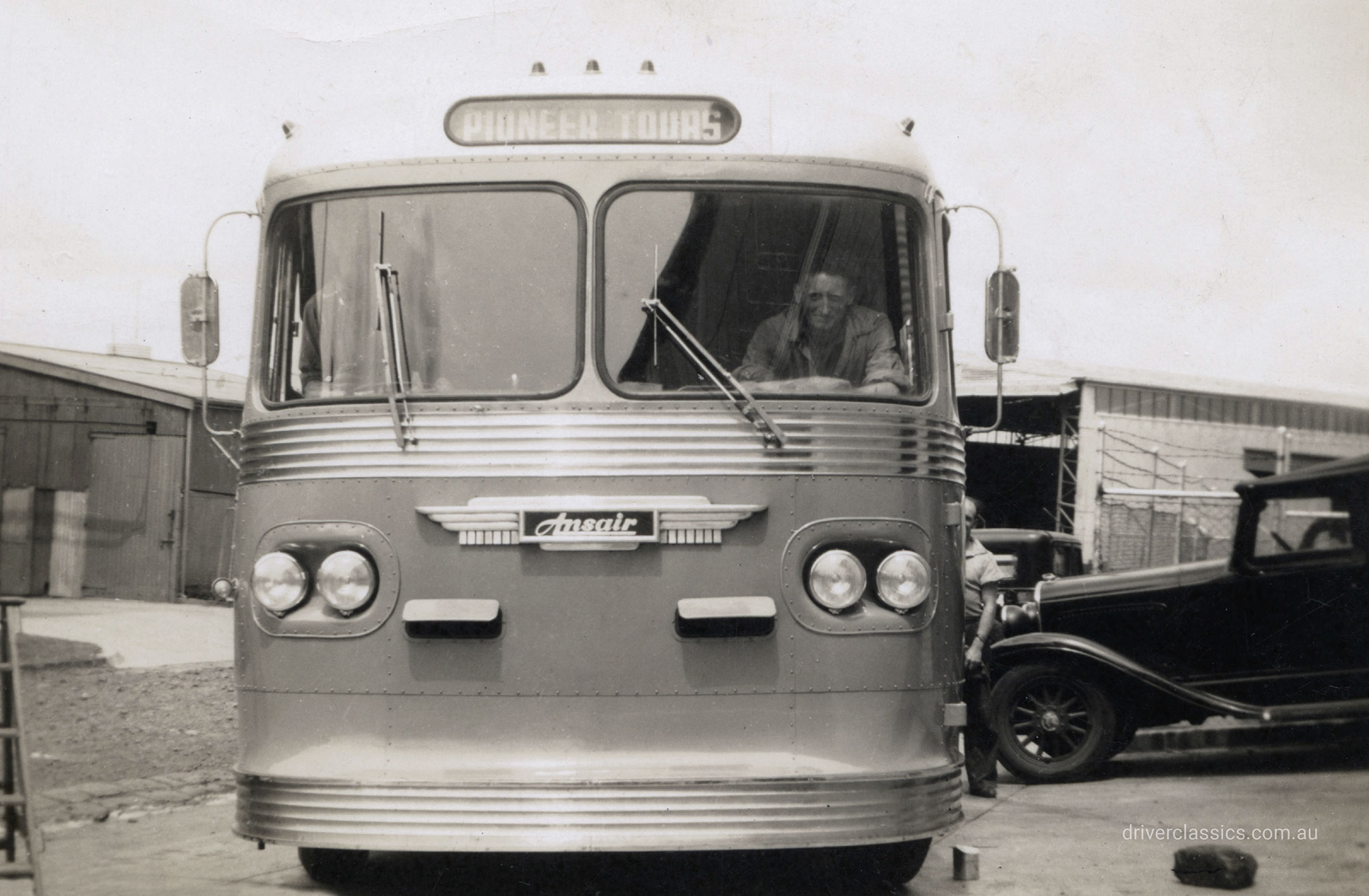
Ansair executives made two visits to the US in 1947 visiting US coach builder Flxible. On the home front, Ansair was busy building a new coach aimed at meeting the needs of Pioneer’s long distance tours and routes. It was a Reo Pusher model 96H (rear engine) chassis, 31 feet in length with a prototype Ansair body that was heavily influenced by Flxible and US styling in general, garnered after the first US visit to Flxible by Ansair executives. The 1947 Ansair Reo Pusher also faced over length issues like the favoured GM ‘Silversides’.

Original documents reveal that Pioneer obtained a special import license, #342261 on August 8 1947 covering the importation of: “one (1) complete ‘Pilot’ model Flxible Clipper 29B1-47 from the USA into Australia along with one (1) complete range of unassembled components, the dollar values respectively $9,000 and $5,000 making a total of $14,000”. Pioneer was granted the import license a few months prior to the introduction on January 1 1948 of the Australian government’s currency restrictions limiting trade with the USA. The use of the word ‘Pilot’ on the import documentation was to signify the Clipper 29B1-47 as an evaluation model to ensure compliance with import regulations and tariff requirements.
On August 19 during the second US visit in 1947, Ansair General Manager Gil Cornish signed an agreement with the Flxible Corporation to import one Flxible Clipper, along with unassembled components and the rights to build Clippers locally in Australia. This put an end to any further development of the Ansair Reo Pusher prototype and it became a one off that was short lived in the Ansett organisation.

When Pioneer’s 1947 Flxible Clipper 29B1-47 arrived in Australia on October 31 1947, it became the most advanced coach ever to operate in this country. Its unique streamlined shape and roof mounted air scoop was a standout in modern coach design. The Clipper’s fuel efficient light weight all metal construction, featured a rear mounted in-line Buick Fireball 320ci, ‘straight 8’ petrol engine. Seating capacity was 29 luxurious reclining parlour seats with foot rests while luggage was carried in a large compartment just ahead of the rear mounted engine. The pilot model 1947 Flxible Clipper, Ansair serial number P3, later fleet number D2 and originally registered MM-210, still exists today and has had a full restoration.
1948 saw the pilot Flxible Clipper converted to Right Hand Drive and then act as a ‘template or model’ to facilitate Ansair readying itself for full scale production utilising the imported sub-assemblies and parts to manufacture copies in volume. The pilot Flxible Clipper completed demonstration tours in 1949 for operators and government officials and set about proving itself in Australia’s harsh conditions.
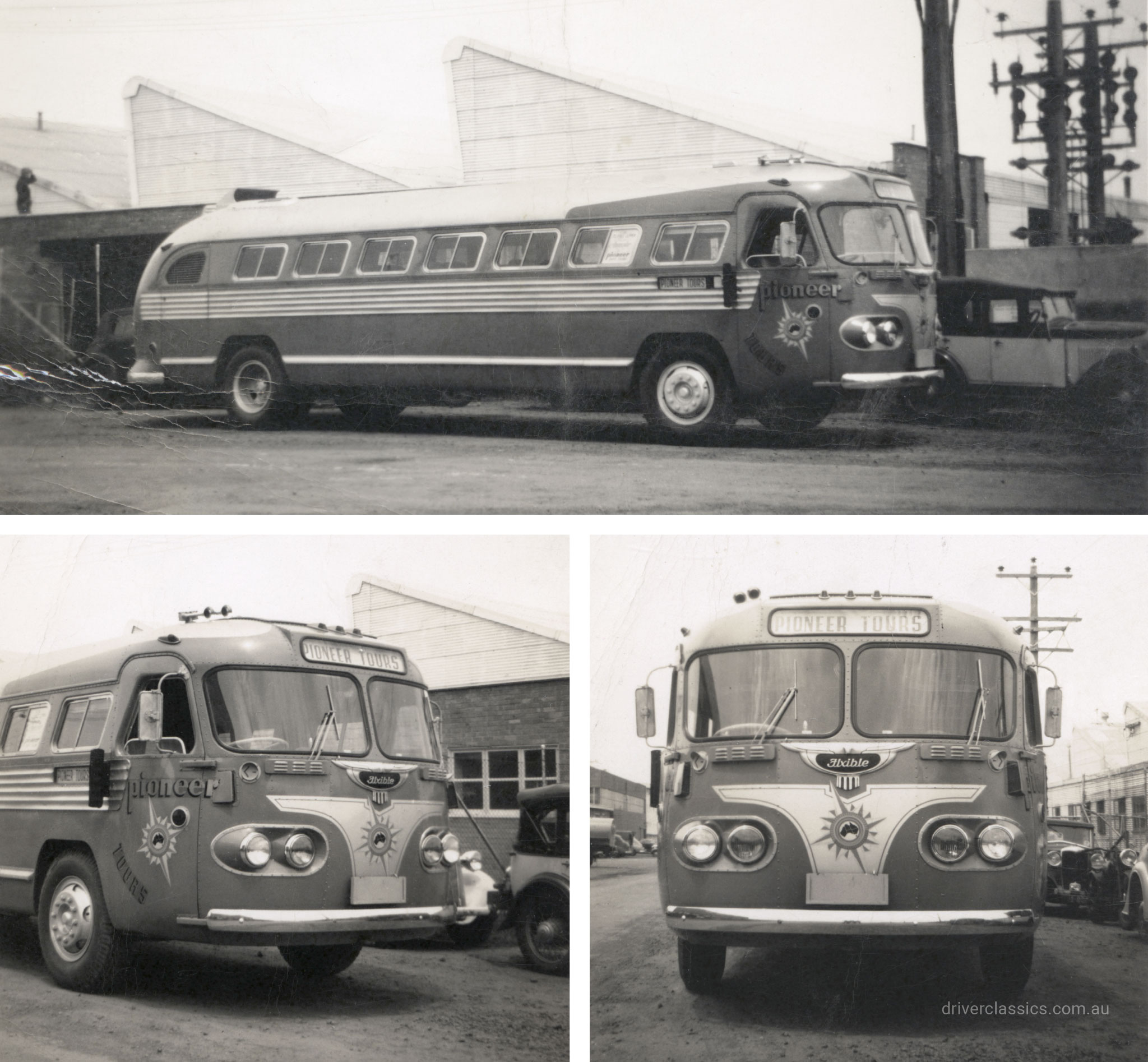
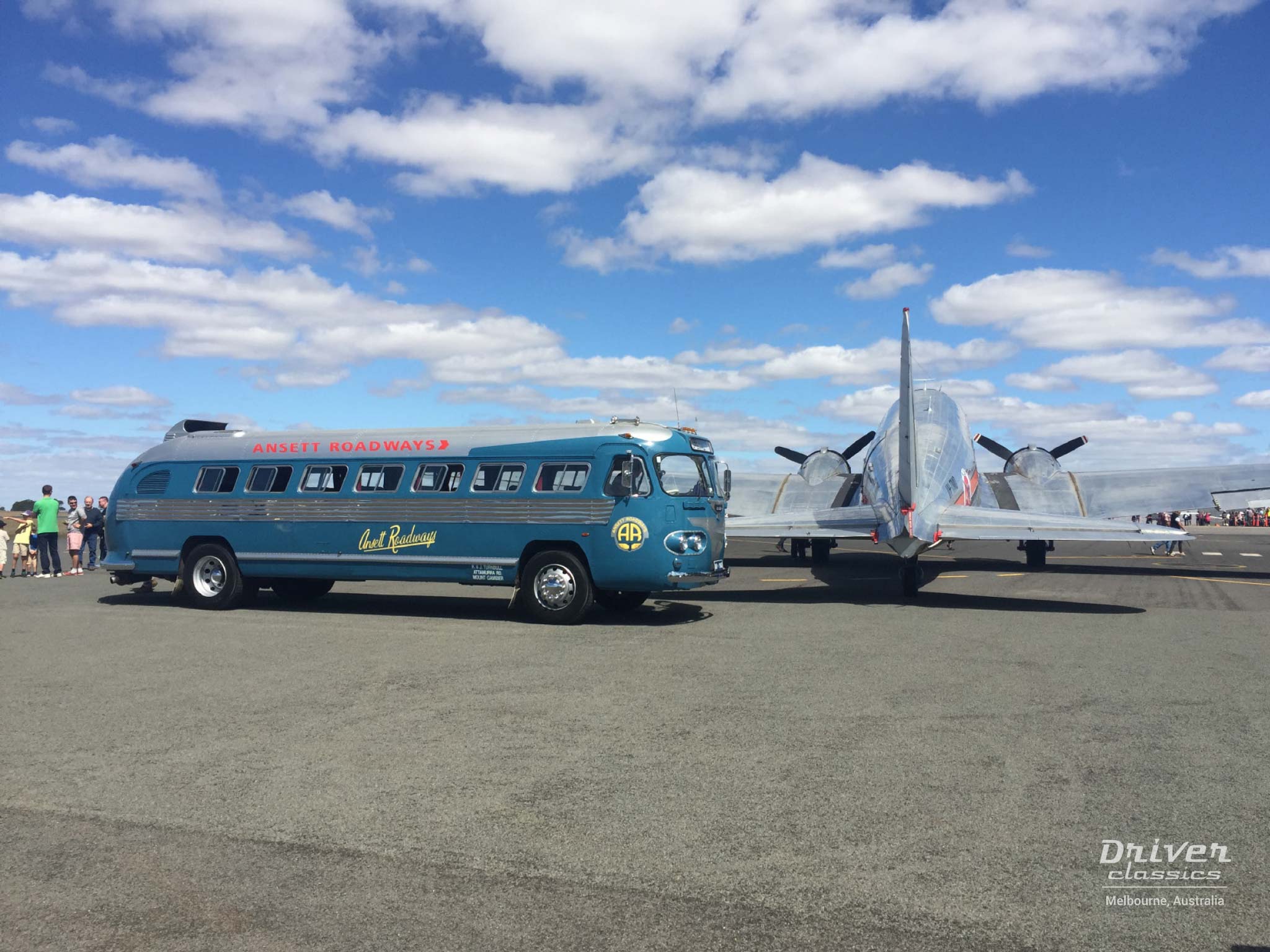
To address Pioneer’s immediate need for coaches prior to Australian Clipper production commencing, in 1949 and 1950 Ansair built 32 Commer Avenger ‘Scenic Clippers’ for Pioneer’s short haul work. The front end design had a strong similarity to the imported pilot Flxible Clipper 29B1-47 and it complied with the State of Victoria’s 27 feet 6 inch length limit.
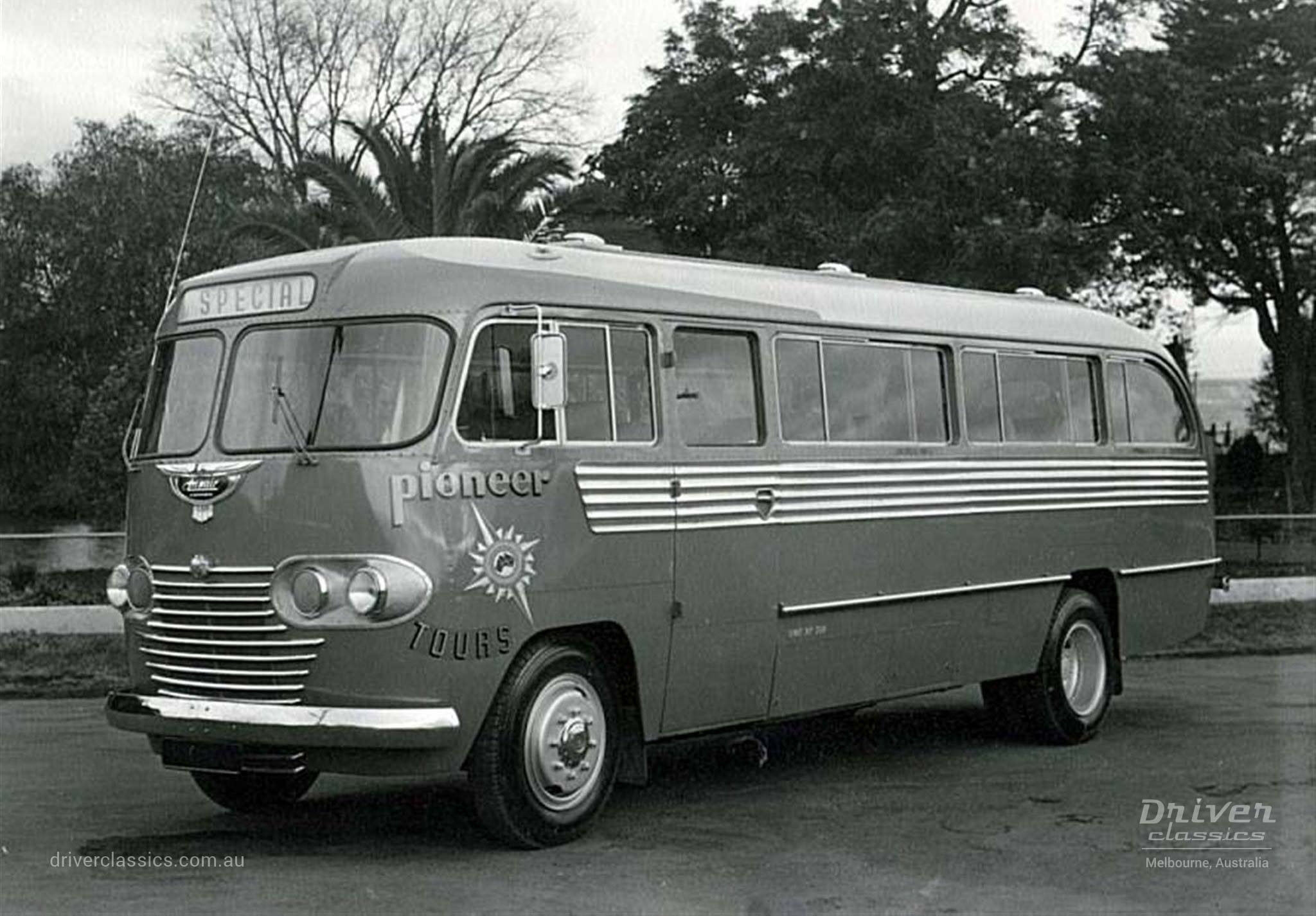
Around September 1950, the maximum length in the State of Victoria was increased to 33 feet, allowing Ansair’s local production of the Clipper to finally commence.
From December 1950 until June 1960, 131 Clippers were built under license to the Flxible Corporation, Ohio USA at Ansair’s Essendon plant in Melbourne. All but 3 Ansair built Clippers featured the new larger ‘Visicoach” windows that had recently been introduced by Flxible in the US instead of the smaller original ‘Airporter’ styled windows.
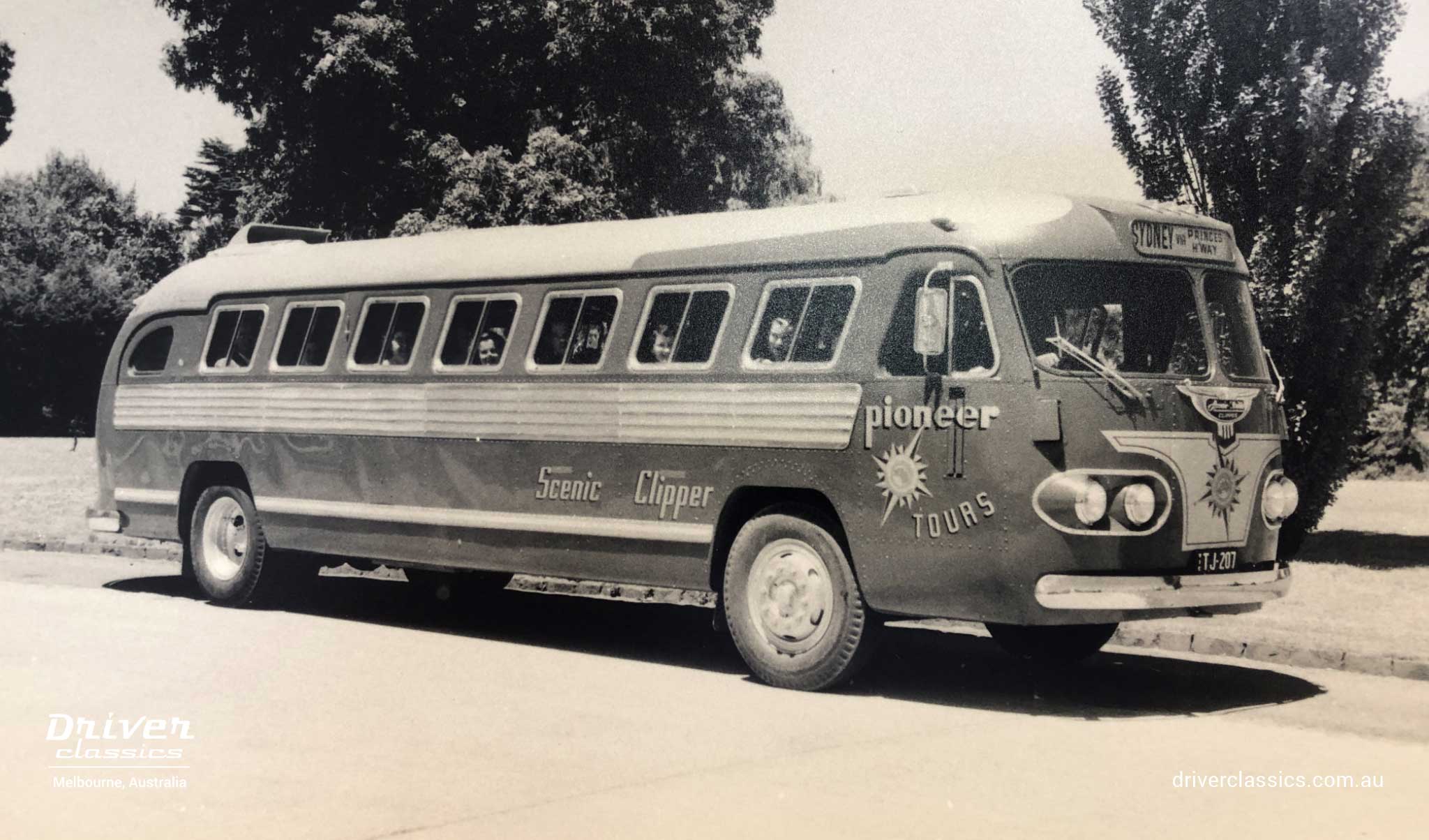
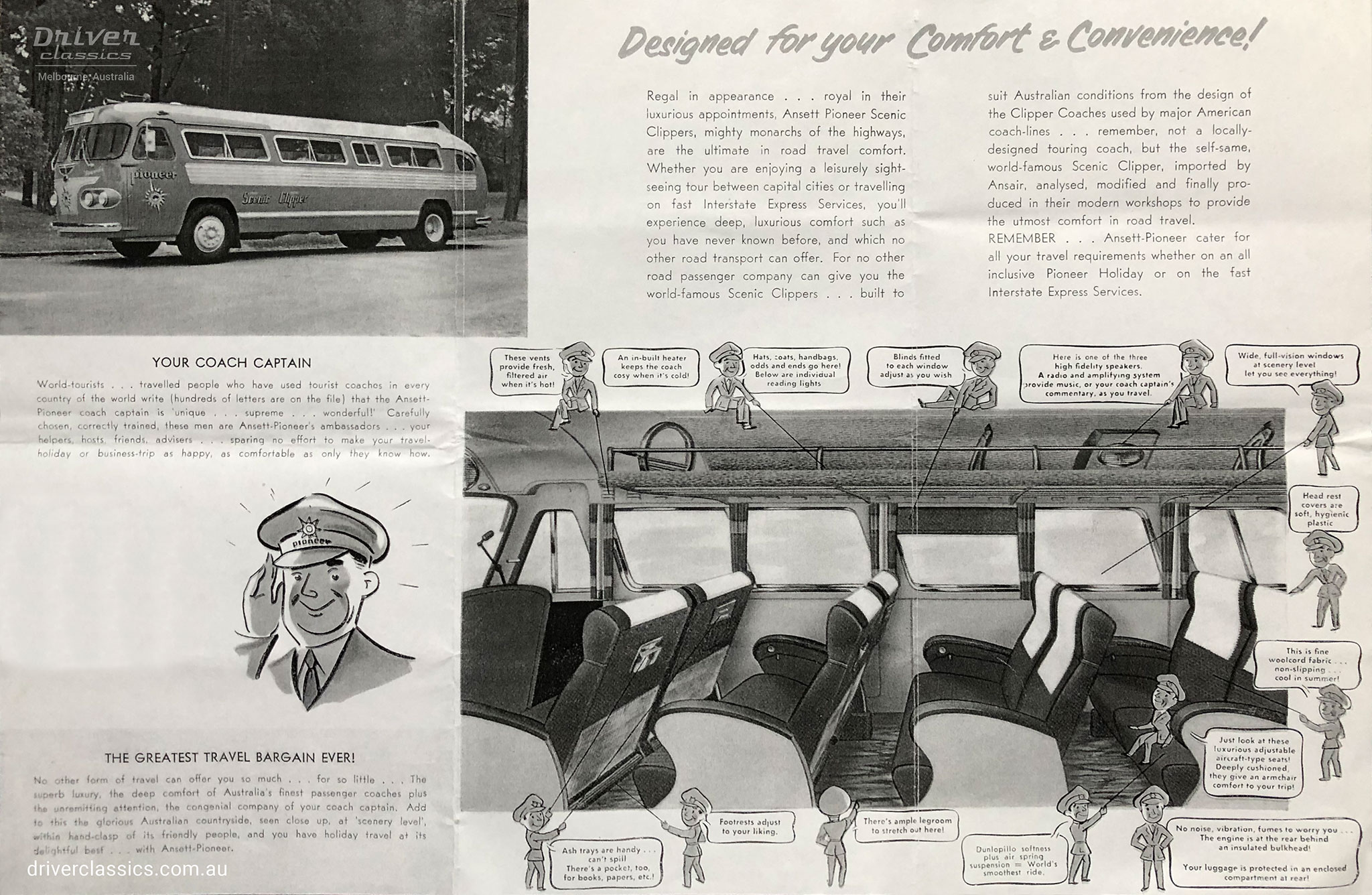

The Ansair Flxible Clipper was offered in two models: 6a and 6b. The Clipper Tourist Model 6a offered the latest ‘Visicoach’ long windows and aircraft style reclining parlour seats while the Clipper Intercity Model 6b offered the small original ‘Airporter’ windows with bag type seats and optional ‘head rolls’.
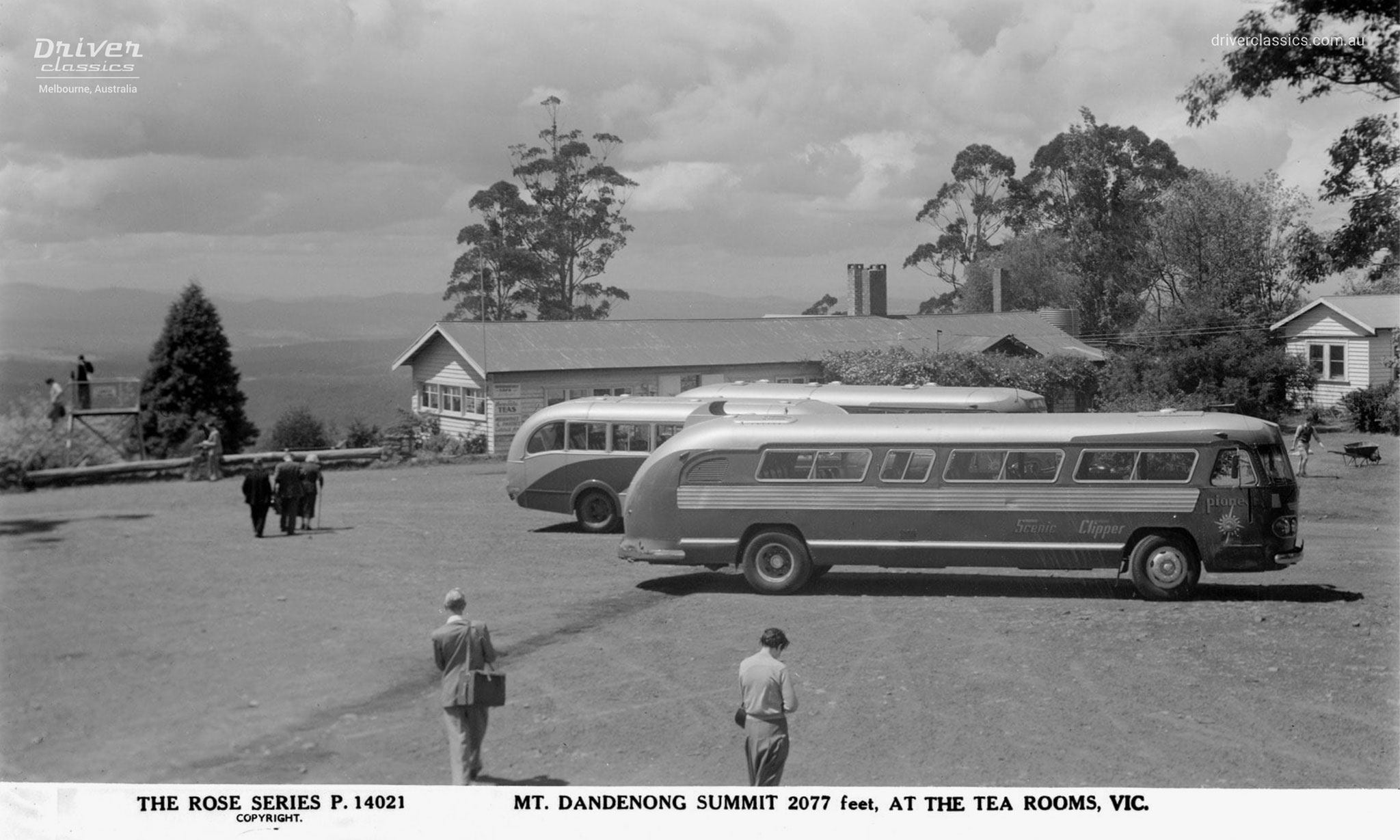
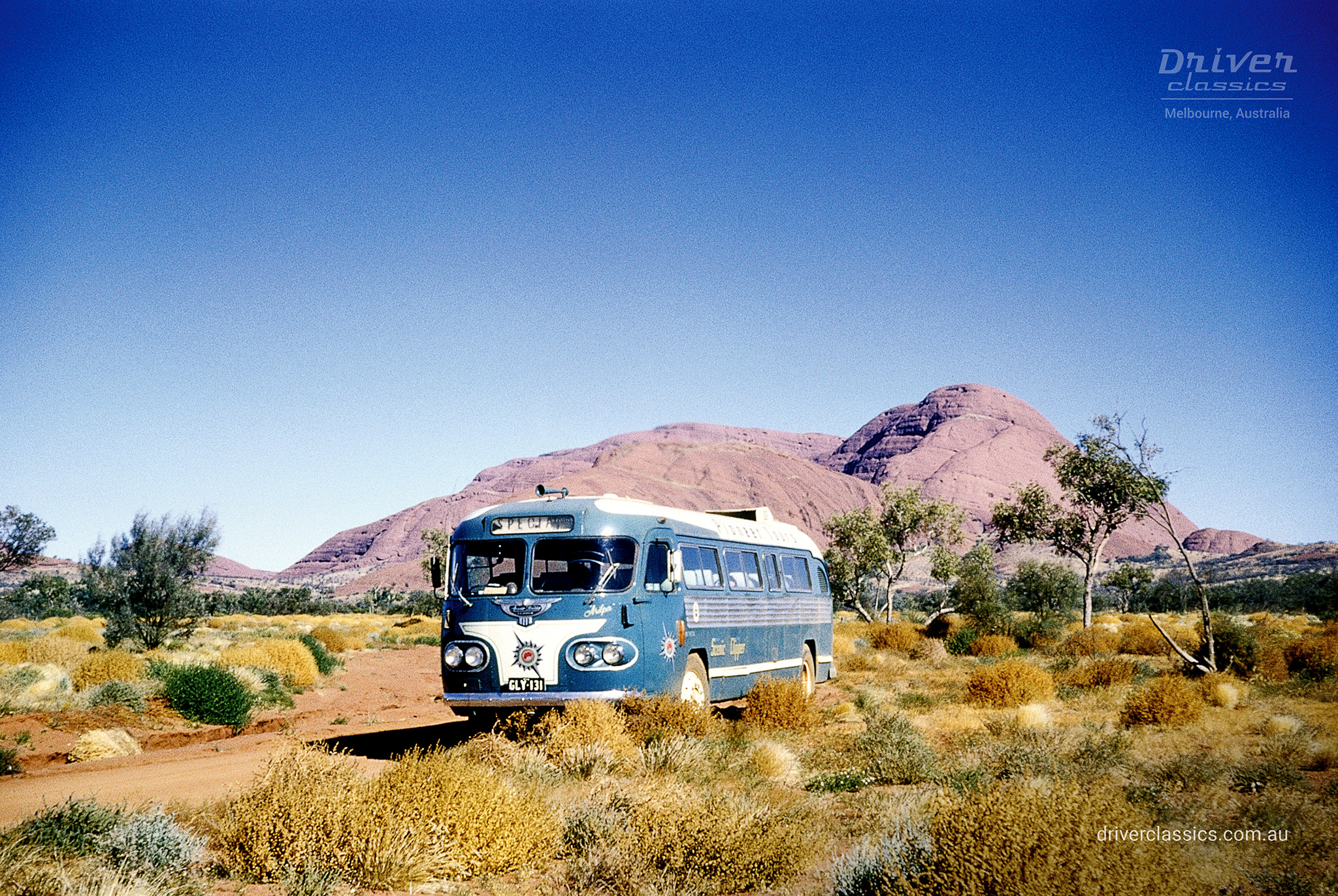

Ansair’s Flxible Clipper production for Pioneer finished with AF129 in November 1958. Ansair built two more Flxible Clippers on special order, AF130 for Cooks, Tasmania in June 1960 and AF131 for Green Coach Lines, Tasmania in June 1960. Over a ten-year period, Ansair had built 131 Flxible Clippers at its’ Essendon plant in Melbourne for the following operators: Pioneer – 100 units, Ansett Roadways – 11 units, Ansett Airways – 4 units, Benders Geelong – 2 units (all aluminium construction), Newman’s New Zealand – 6 units, Sullivans Coach Lines Tasmania – 2 units, Green Coach Lines Tasmania – 3 units, and Cooks Sedans Tasmania – 3 units.
With US trade restrictions firmly in place, sourcing of non-US components to use in local Clipper production proved difficult and resulted in a variety of UK and locally sourced components being used in Ansair built Flxible Clippers.
The first fifty-one Ansair Flxible Clippers used Leyland AU450 diesel engines with a 4 speed Spicer constant mesh direct drive transmission. The Leyland AU450 diesel was an upgraded civilian derivative of the Leyland 7.0 litre Matilda tank engine. This was followed by twenty Cummins JBS600 diesel engines and finally sixty air-cooled Deutz F6L614 and F6L714 diesels. None of these engines were particularly suited to Pioneer’s requirements with the Leyland engines being reasonable performers but without the engine life required, the Cummins engines good performers but also found wanting in durability, while the Deutz engines performed well but had head issues.
By the mid-1950s, local Flxible Clipper production was in full swing but Reg Ansett was still not content. He wanted to import General Motors latest model, the GM PD 4104 but the Australian government currency restrictions were still in force and put paid to any idea of importing GM PD 4104s.
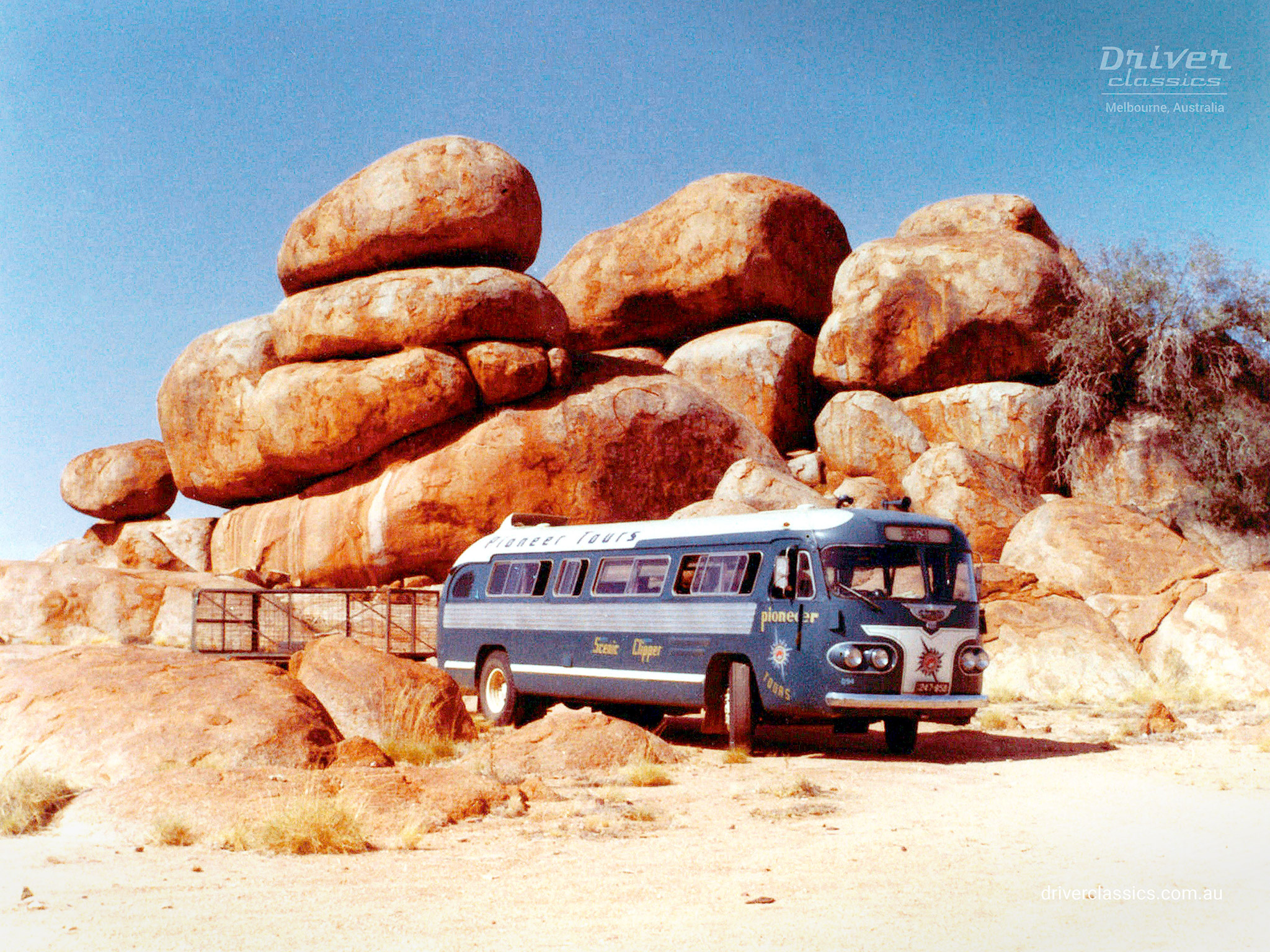
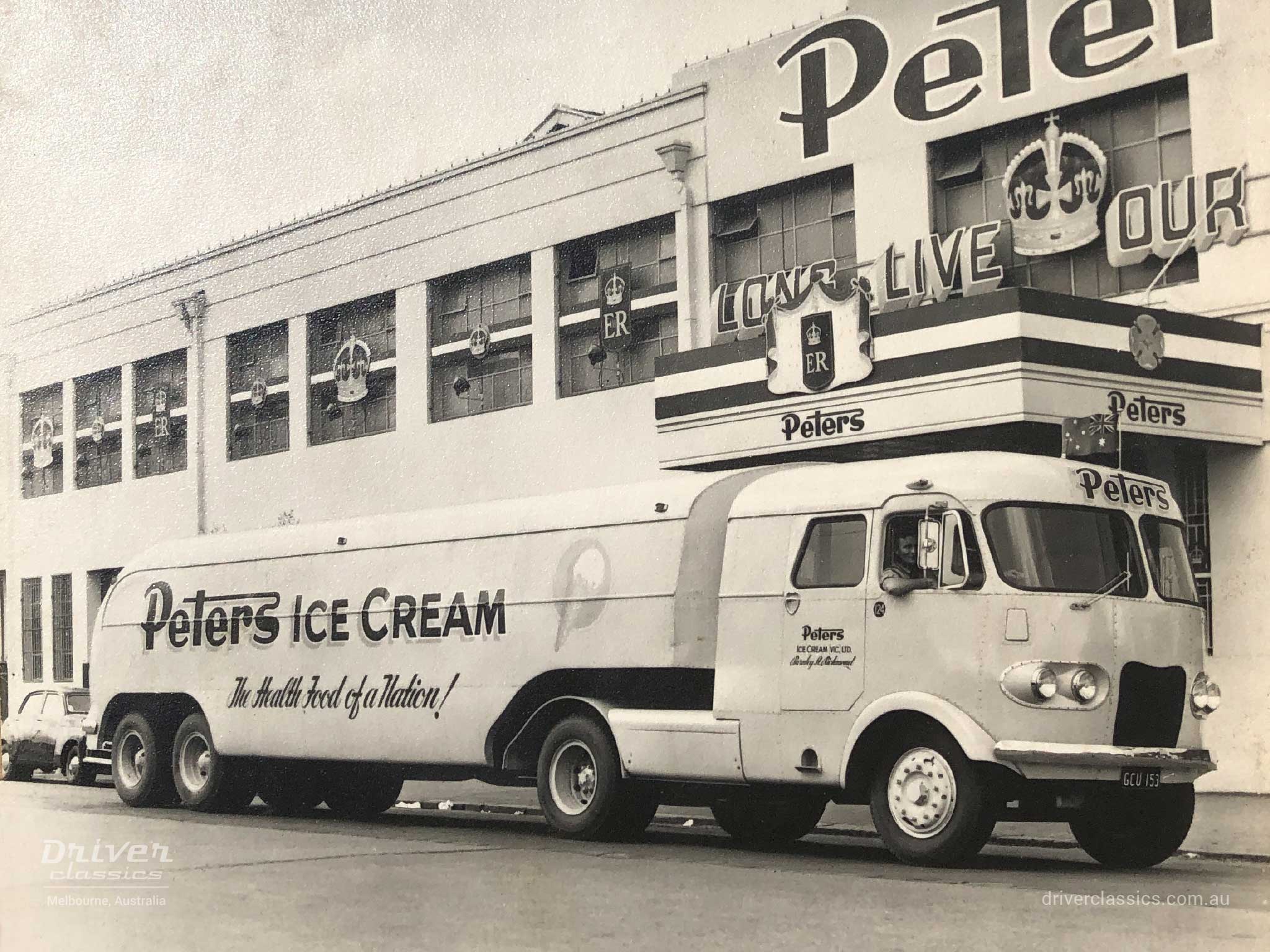
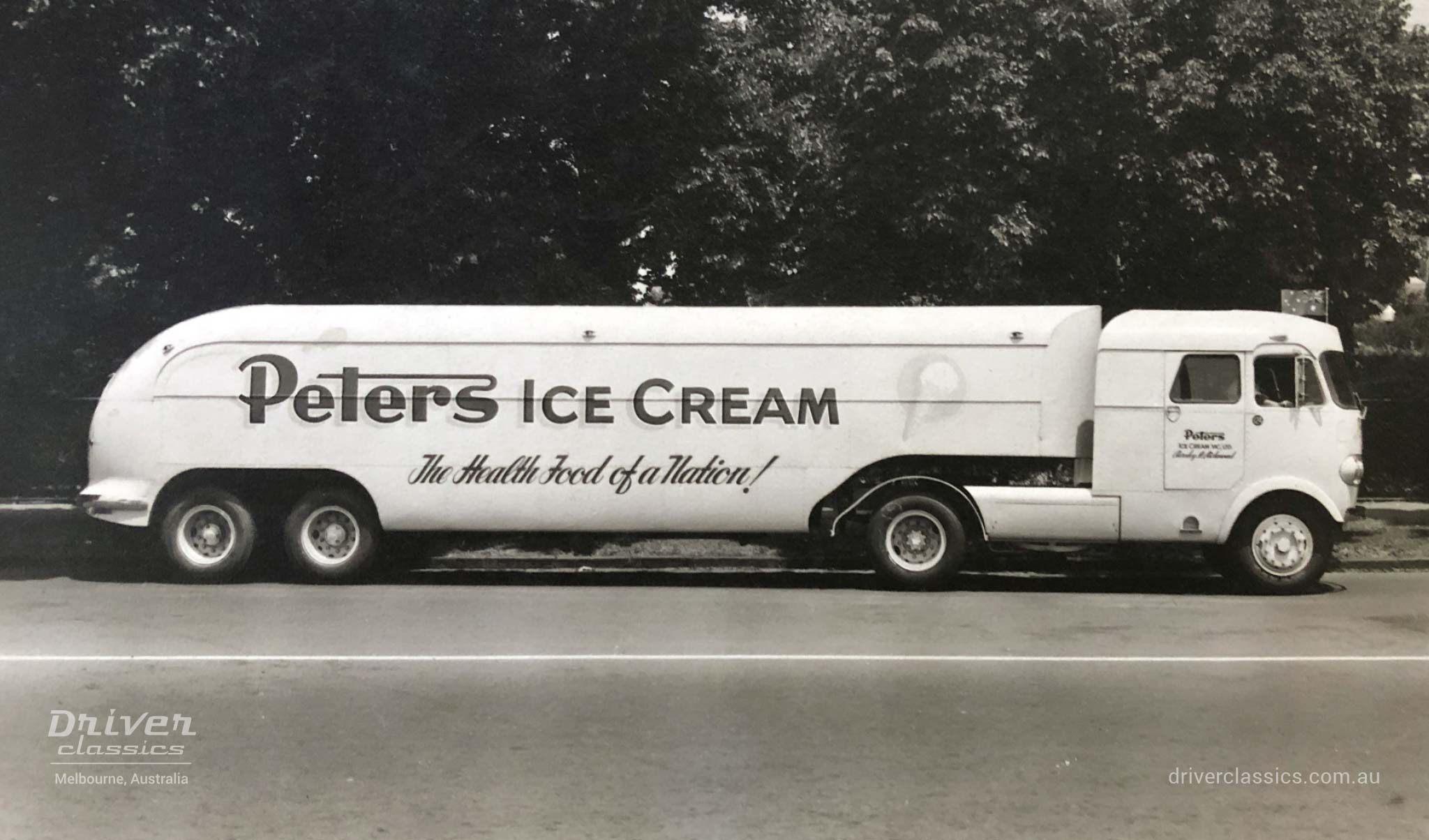
The advanced design of the Ansair Flxible Clipper coach enabled Pioneer to establish the first non-stop express service between Melbourne and Sydney on January 24 1955, after the findings of the Hughes and Vale case in late 1954 cleared the way for unimpeded travel over state borders. Although the Ansair Flxible Clipper raised the bar and was superior to any other coaches operating in Australia at the time, Reg Ansett’s quest to fulfil his vision of the ultimate long distance coach would not stop.

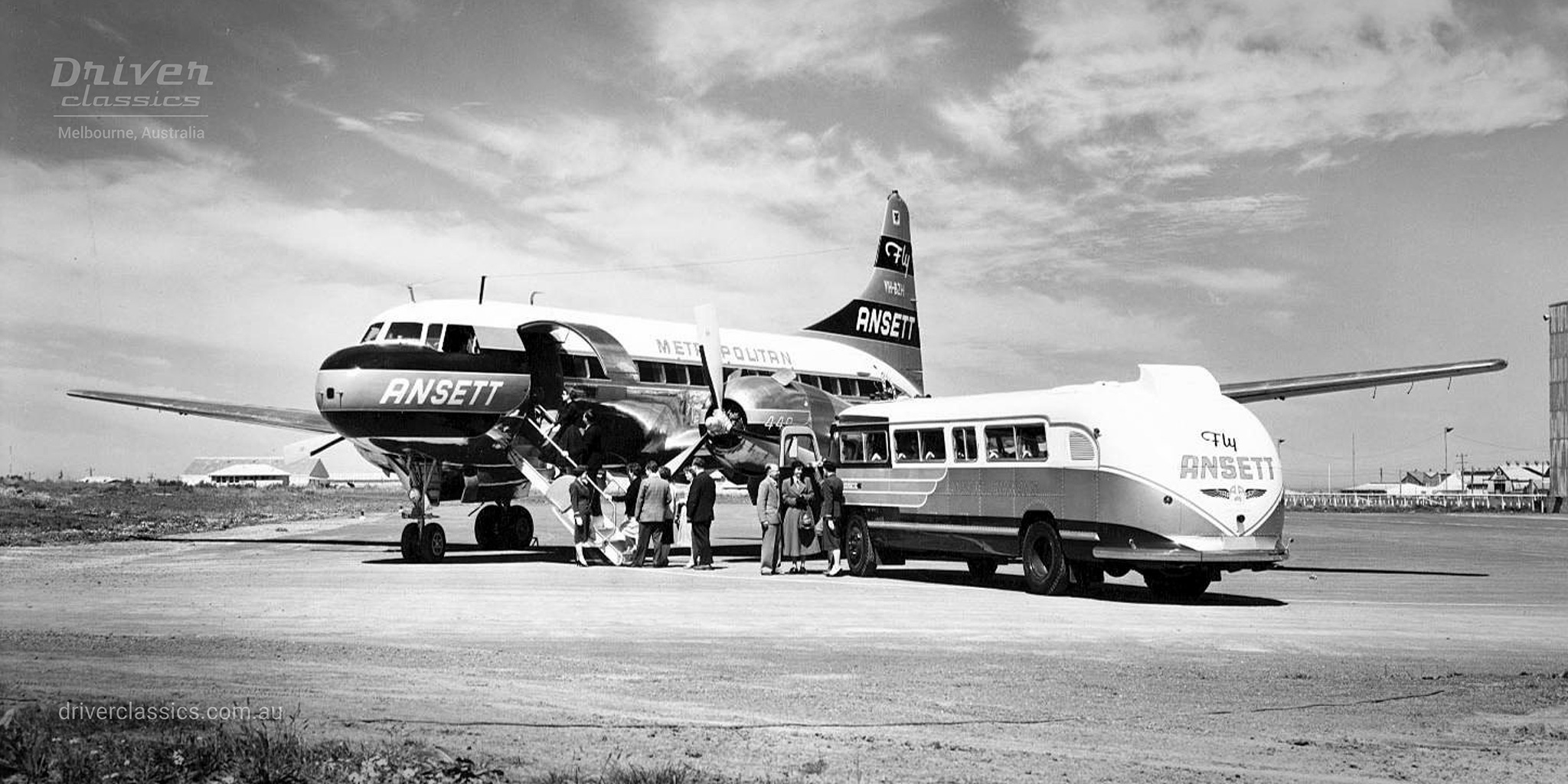

In 1957, Ansair commenced building 15 mid-engine Leyland Worldmasters for Pioneer’s interstate express services but they were short lived on express suffering from weight, noise and reliability problems. The Leyland Worldmasters were reconfigured and relegated to sightseeing work.
In the late 1950s, Pioneer had Ansair build another prototype coach, an exceptionally stylish 41 seat Ansair Jupiter model AJ1 with an air-cooled rear engine Deutz and an aluminium monocoque design. It was introduced in October 1960 and despite its advanced light weight construction, the Jupiter’s high cost combined with the use of heavy componentry resulted in it becoming overweight and therefore ending up as a one off for Pioneer.

Right: 1960 Ansair Jupiter in its later Pioneer Tours colours with blue grille.

Finally, US currency restrictions were lifted on February 15 1961 and on that same day Ansett placed an initial order to import 10 of General Motors’ latest coach, the GM PD 4106. The GM PD 4106 achieved Reg Ansett’s ultimate goal and became the forerunner to next generation GMs and larger MCI coaches into the future. Pioneer also purchased a considerable number of GM 4-71 diesel engines and in the early 1960s commenced a re-powering program of the Cummins and Deutz powered Clippers. The GM re-powered Clippers provided outstanding reliability and durability and performed to Pioneer’s expectations on long distance work. Some Ansair Flxible Clippers were still serving Pioneer in 1972, a testament to its success.
The Ansair Flxible Clipper introduced a style and flair that created interest in road passenger transport of which none of Pioneer’s competitors could hope to match. The Ansair Flxible Clipper took bus design of the era to a new level with its rear engine and streamlined styling that in turn began a transition of the industry to move on from pre-war conventional, engine out front designs.
-

1936 Federal
-

1947 Bedford OB
-

1948 GM PD 4151
-

1954 Flxible Clipper
-

1959 Bedford SB3
-

1961 GM PD-4106
-

Ansair Scenicruiser
-

1968 GMC PD 4107
-

1972 MCI MC7
-

1976 MCI MC8
-

1983 GM Denning
-

1984 Eagle Model 10
-

1988 Denning Landseer
-

1989 Eagle Model 20
-

1977 Kenworth W925
-

1950 Dodge Pick Up
-

1959 Cadillac
-

1961 Cadillac
-

1962 Ford Thunderbird
-

1968 Ford Fairlane
EX HERITAGE FLEET
